Physical Address
304 North Cardinal St.
Dorchester Center, MA 02124
The anatomies of the eye and visual system are shown in Figs. 43.1 and 43.2 . The optic nerves, made up of the converging nerve fiber layer of the retina, have intraocular, intraorbital, intracanalicular, and intracranial portions. Partial decussation of the optic nerve fibers occurs in the chiasm, which gives binocular visual input to each side of the brain. The visual cortex is where the conscious process of seeing occurs.

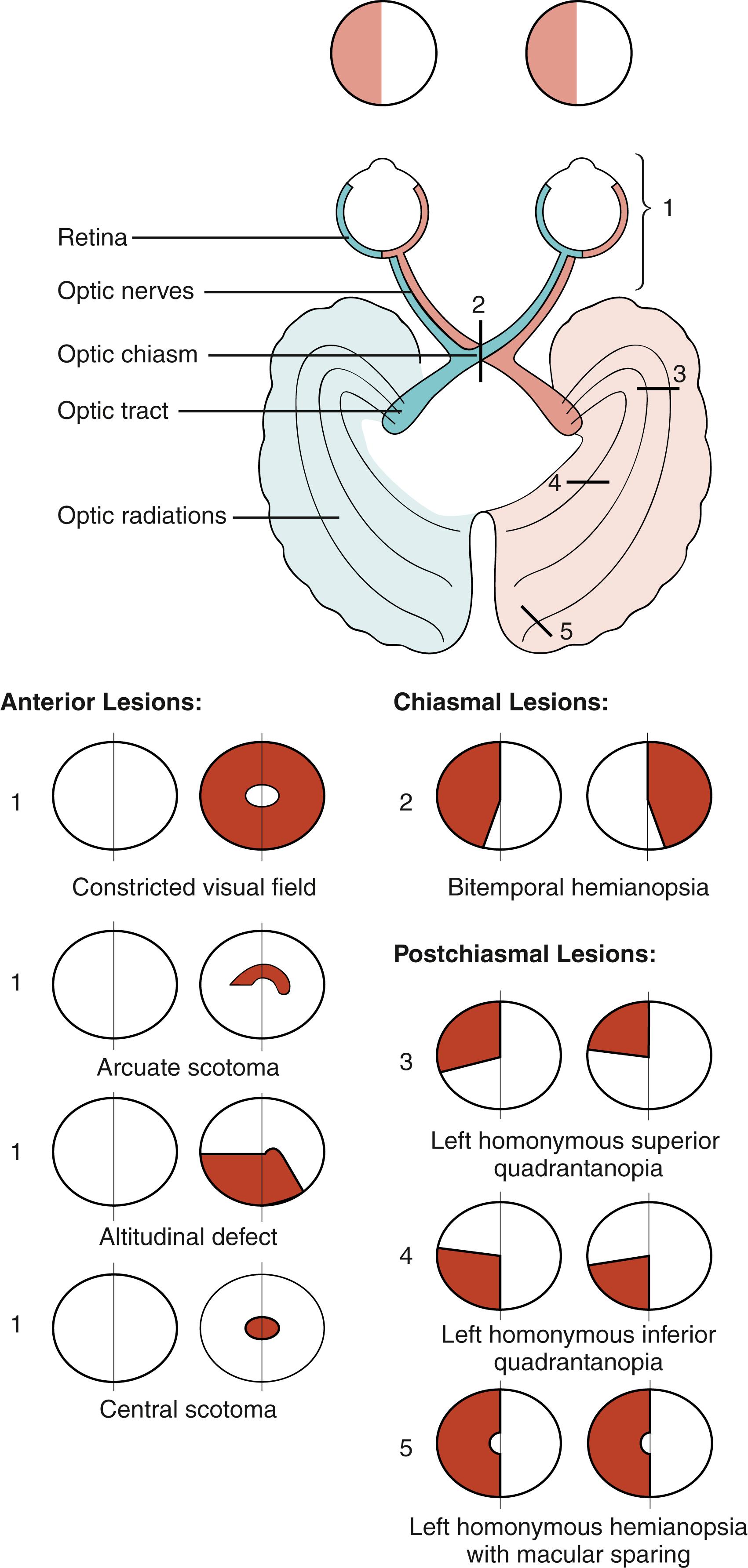
The eyes and vision of a newborn are immature and require several years to reach adult proportions and functional status. By the ninth month of gestation, the retinal vessels have reached the periphery of the retina (an important factor in the pathogenesis of retinopathy of prematurity [ROP]), the optic nerve has completed myelination, and the pupillary membrane has disappeared. Postnatal reorganization of neuron-to-neuron connections in the visual cortex improves the poor visual acuity and other visual processes, which are not fully developed at birth. The visual acuity of the newborn has been estimated to be 20/400–20/600 and may reach the normal 20/20 level as early as 6–12 months of age as tested with visual evoked cortical responses. Acuity of 20/20 is not reached with other types of testing such as preferential looking with Teller acuity cards until ages 3–5 years. Visual acuity measured with conventional letter or symbol recognition methods does not reach 20/20 until 6 years of age because of cognitive factors. Binocular vision, including establishment of normal ocular alignment and depth perception, and improved facility of accommodation, the ability to focus on images at different distances, develop rapidly in the first year of life. The rapid maturation of visual function in the first year of life accounts for the critical period of visual development and the extreme sensitivity of the visual system to abnormal visual input from strabismus or cataracts. Children deprived of vision in this critical period will have limited visual potential and may develop nystagmus (abnormal eye movements).
The majority of newborns are moderately hyperopic. Heredity contributes to the refractive status of the eyes and the environment and visual experience also plays a role.
Amblyopia is defined as a unilateral or, less commonly, bilateral reduction in visual acuity that cannot be immediately corrected with glasses or surgery. In children whose visual acuity can be accurately measured, a practical definition of amblyopia is a two-line or greater difference between the best-corrected visual acuity of the eyes. For preverbal children, differences between the eyes in fixation and following behavior or fixation preference are used to diagnose amblyopia. Automated photoscreeners can aid in the diagnosis of risk factors for amblyopia and strabismus, particularly in preverbal children who perform poorly on subjective testing. Amblyopia results from abnormal visual experience early in life during the critical period for visual development. The sensitive period for amblyopia starts in early infancy and continues to at least the age of 6 years and sometimes beyond the age of 8 years. There is a suggestion of cortical plasticity in adults that may allow for some vision improvement into adulthood. The prevalence of amblyopia in the North American population is 2–4%.
Unilateral amblyopia results from three types of abnormal visual experience: strabismus, anisometropia (unequal refractive errors), and monocular visual deprivation (e.g., cataract, corneal opacity, hemangioma [severe ptosis]). Bilateral amblyopia results from bilateral media opacities or significant bilateral refractive errors (ametropia). Nearly all amblyopia is reversible if discovered at an early age and treated appropriately. Treatment effectiveness declines after the age of 5 years.
Detection strategies for amblyopia can involve early recognition of factors that give rise to amblyopia or actual measurement of reduced visual acuity that may be caused by amblyopia. Most amblyopia risk factors can be detected through routine pediatric screening such as ocular history, red reflex evaluation, ocular motility, and vision assessment. Recommended screening and referral guidelines are shown in Table 43.1 . Whenever possible, a line of symbols or isolated symbols with surrounding crowding bars is recommended for screening ( Fig. 43.3 ). Isolated symbols can lead to overestimates of the visual acuity of an eye with amblyopia due to a crowding phenomenon or contour interaction in which symbols of a given size are more difficult to recognize if they are surrounded by similar symbols. Hence, visual acuity obtained with single optotypes without crowding bars can result in failure to detect amblyopia.
| Age | Tests | Referral Criteria Comments |
|---|---|---|
| Newborn to 12 mo |
|
|
| 12–36 mo |
|
|
| 36 mo–5 yr |
|
|
| 5 yr and older ∗ |
|
|
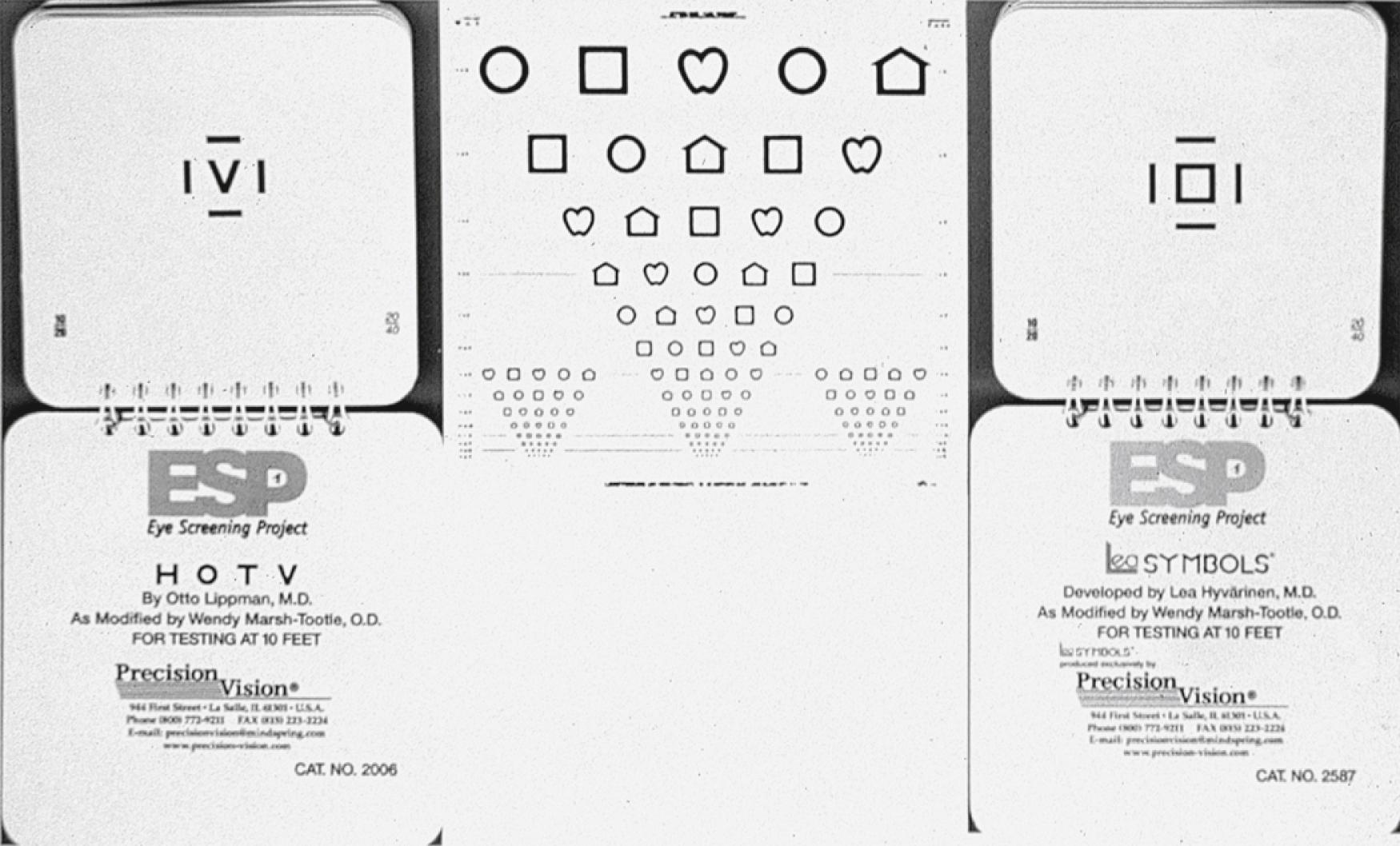
The treatment of amblyopia involves eliminating amblyopia risk factors, providing a focused retinal image with appropriate optical correction, and forcing use of the amblyopic eye through occlusion of the sound eye or blurring the image the sound eye receives. For patients with visual deprivation amblyopia, the depriving factor must be addressed medically or surgically. Optical correction including a bifocal is required for patients who have had cataract surgery. Intraocular implants are not generally placed in children under 1 year of age due to the high postoperative complication rates. For patients with anisometropic amblyopia, optical correction usually involves spectacles or, less commonly, contact lenses.
An adhesive patch worn over the sound eye most commonly achieves forced use of the amblyopic eye. Occlusive devices can be attached to glasses but may be less reliable since the child can peek over the glasses or around the occlusive device. The use of the potent cycloplegic agent atropine sulfate may also be used to encourage use of the amblyopic eye. A drop of atropine is applied to the sound eye each day; this temporarily impairs its accommodative ability and, in the presence of sufficient hyperopia, prevents that eye from obtaining a clear retinal image. Atropine “penalization” for amblyopia works best in hyperopic patients with mild to moderate amblyopia (visual acuity of 20/100 or better). Close follow-up of patients being treated for amblyopia is important for monitoring compliance with treatment and for preventing the development of iatrogenic reverse amblyopia in the sound eye from excessive occlusion or penalization.
Quantitative testing of the visual field of most children is difficult before the age of 10 years (see Fig. 43.2 ). Confrontation field tests can be performed to detect gross abnormalities of the visual field (hemianopsias), but even these are not reliable and need to be confirmed at an older age. Visual field defects in children are uncommon despite parental concerns about a child who seems to bump into objects frequently. Unilateral retinal or optic nerve disease can produce unilateral visual field defects, but these are almost always associated with reduced visual acuity in the involved eye. Bilateral visual field defects, particularly if symmetric (homonymous), indicate disease of the optic radiations or visual cortex. Visual acuity may be entirely normal. Causes of bilateral visual field defects in children include cerebrovascular accidents, pituitary or hypothalamic tumors, or congenital central nervous system (CNS) abnormalities.
Strabismus is derived from the Greek word strabismos , “to squint to look obliquely or askance.” It implies misalignment of the eyes in such a way that they are not simultaneously viewing the same object. Terms to describe eye alignment and movement are noted in Table 43.2 . Strabismus can be constant or intermittent and can be the same in all directions of gaze (comitant) or greater in one direction of gaze than in others (incomitant). Furthermore, it can be categorized as congenital or acquired, monocular or alternating. The direction of misalignment can be vertical or horizontal. Vertical strabismus is referred to as a hypertropia of the higher eye. Horizontal strabismus can be convergent (esotropia) or divergent (exotropia). The importance of strabismus detection derives primarily from the fact that it is the leading cause of amblyopia. Other reasons for detecting strabismus are the possibility of being able to restore normal binocular use of the eyes, improving depth perception, and minimizing the social and economic drawbacks to strabismus in society.
| Normal Ocular Alignment: Orthophoria |
| Latency |
|
| Direction of Deviation |
|
| Equality of Deviation |
|
| Neuromuscular Dysfunction |
|
| Tandem Movements of Both Eyes |
|
Strabismus detection can be simple, as in patients with a large angle of deviation ( Fig. 43.4 ), or difficult, as in patients with more subtle deviations or no deviation at all (pseudostrabismus) ( Fig. 43.5 ). Evaluation of the symmetry of the corneal light reflexes from a penlight directed at the eyes can reliably detect many cases (see Fig. 43.4 ). With smaller angles of strabismus or when the results of the corneal light reflex are in doubt, the cover test should be performed ( Fig. 43.6 ). It is important to provide attractive fixation targets for the child to view during the test.

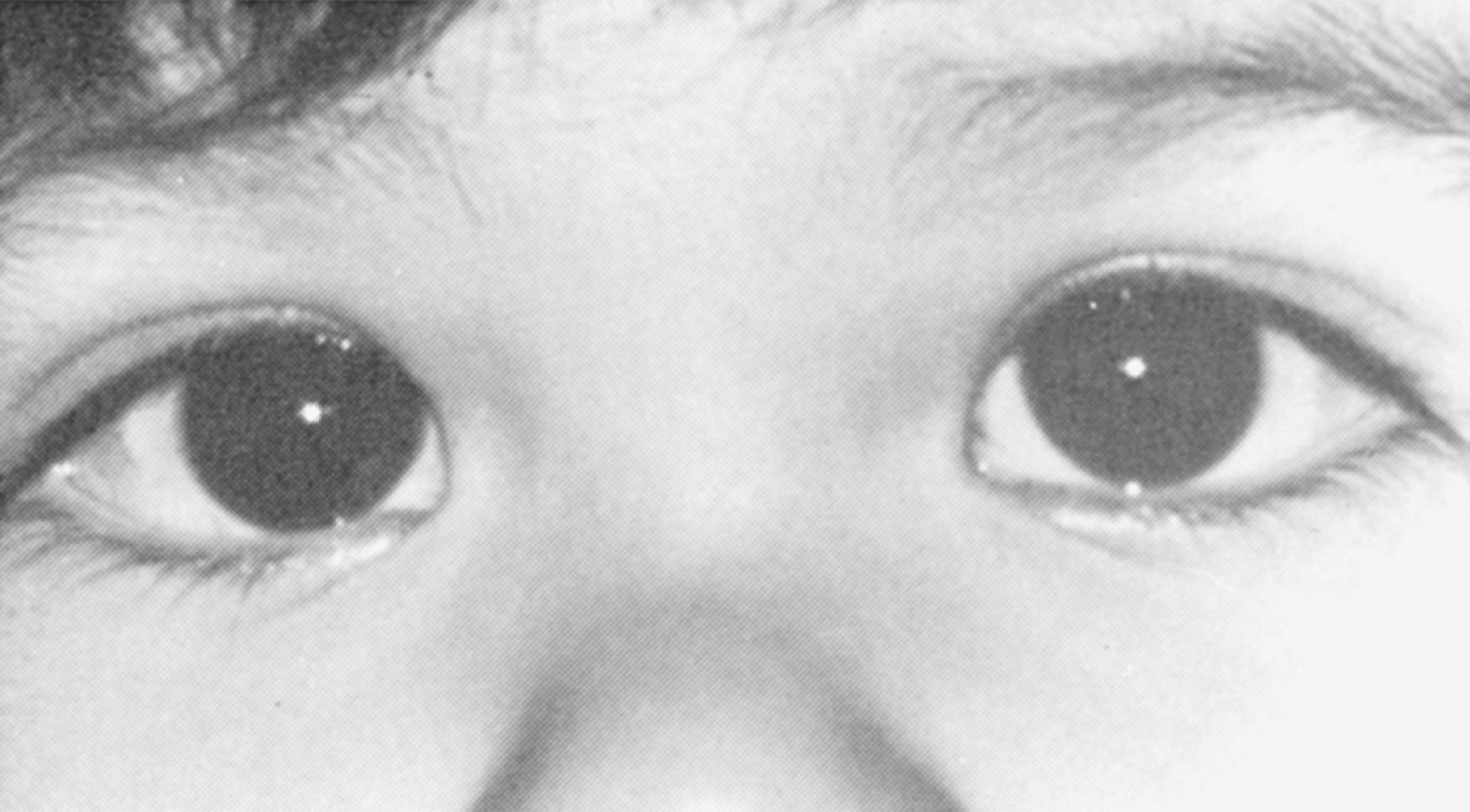
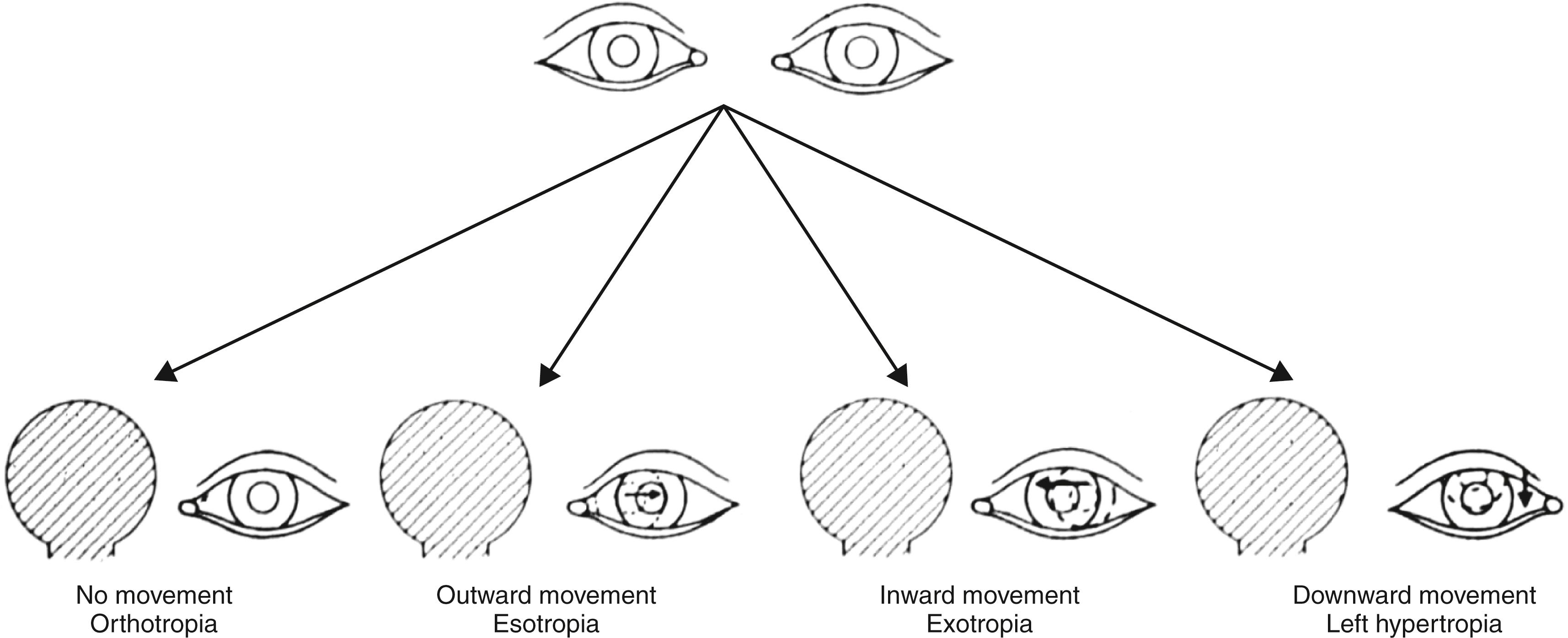
Infantile esotropia is defined as convergent strabismus with onset within the first 6 months of life (see Fig. 43.4 ). Transient crossing or divergence of the eyes is common in newborns and is probably not significant unless it persists beyond 3 months of age. In the classic form of infantile esotropia, there is a large-angle, constant deviation. The child may alternate fixation (cross-fixate), in which case the visual acuity is usually good in both eyes. Cross-fixation may mimic bilateral sixth nerve palsy. If the crossing is present in only one eye, amblyopia occurs in the nonfixating eye. Binocular vision is disrupted in infantile esotropia. The cause of infantile esotropia is not known, but hereditary factors play a definite role. The incidence of infantile esotropia is <1% among neurologically normal infants.
Early surgical correction of infantile esotropia may result in full or nearly full restoration of normal binocular function, a result not believed to be obtainable with correction of misalignment at older ages. The ideal timing of surgery for infantile esotropia is not known, but children operated on before 2 years of age are more likely to obtain binocular single vision. Early detection and prompt referral of infants with suspected esotropia are indicated.
A second category of esotropia occurs in children whose eyes are initially straight but start to cross, usually intermittently at first, at 1–3 years of age. These children have excessive hyperopia and an abnormal relationship between accommodation and convergence. This type of esotropia is called accommodative esotropia . Amblyopia frequently develops. Treatment consists of correcting amblyopia and providing spectacles to correct hyperopia, thereby modulating the amount of accommodation required by the child ( Fig. 43.7 ). Bifocal spectacles may also be necessary for some forms of accommodative esotropia.
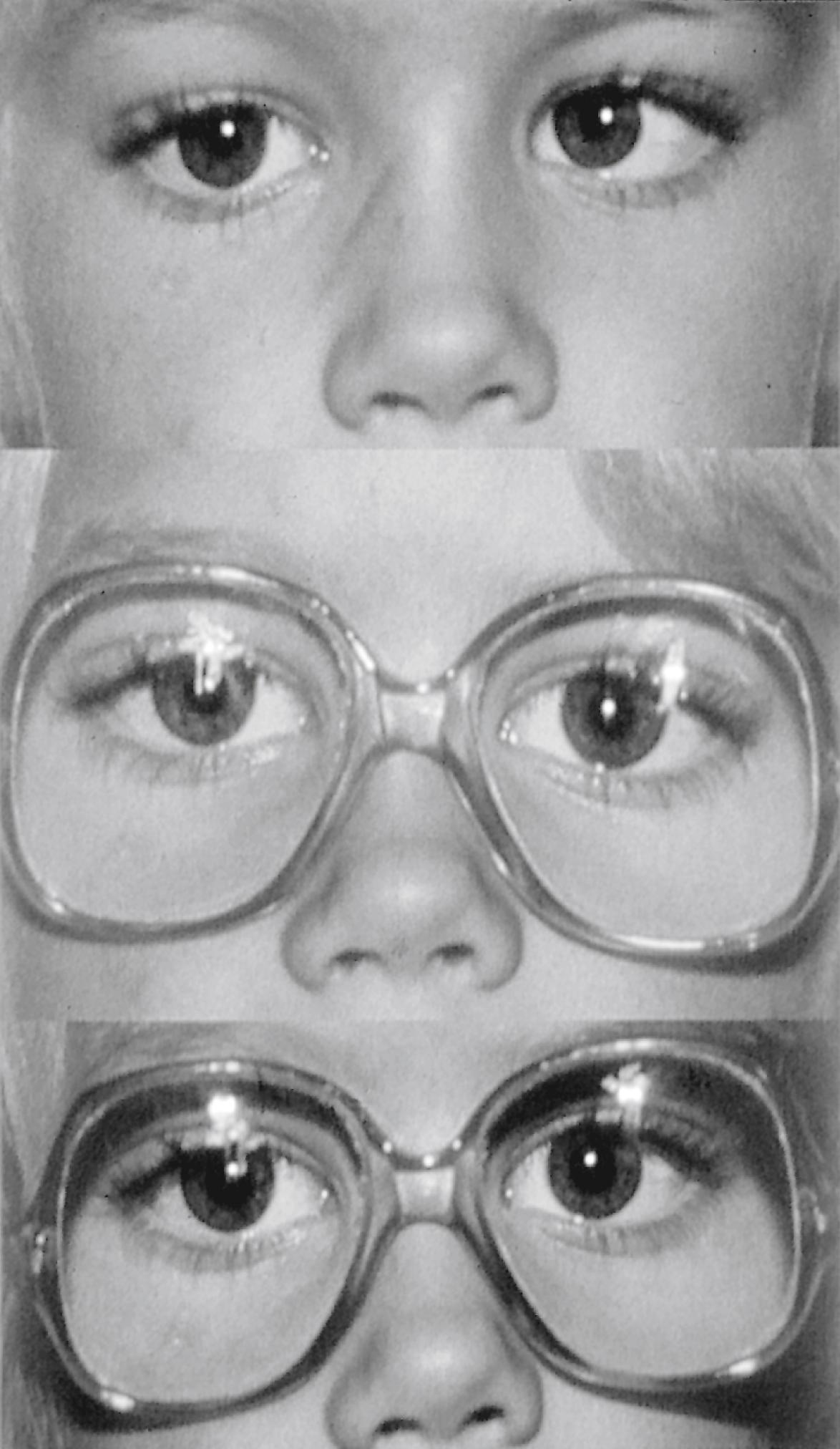
Esotropia caused by paralysis of a lateral rectus muscle, a sixth cranial nerve palsy, occurs much more frequently in children than in infancy ( Fig. 43.8 ). Approximately 30% of children will have an intracranial tumor (brainstem glioma, medulloblastoma, ependymoma, craniopharyngioma). Other causes include head trauma or a recent benign viral illness. The sixth nerve palsy may resolve spontaneously if the cause is benign. Other acquired etiologies include acute demyelinating encephalomyelitis (ADEM) or multiple sclerosis (MS), Lyme disease, pontine vascular malformations, raised intracranial pressure (nonlocalizing), and middle ear infection complicated by petrous apicitis (Gradenigo syndrome). An older child may present with complaints of diplopia or a face turn or closure of one eye to avoid diplopia, whereas a younger child may present with only the esotropia because of rapid development of suppression to eliminate diplopia. Neurologic investigation is indicated if the history does not support a benign etiology or the paralysis does not spontaneously abate in a few weeks (a so-called benign sixth nerve palsy believed to be postviral in origin) or if the child demonstrates other neurologic impairment or has papilledema.
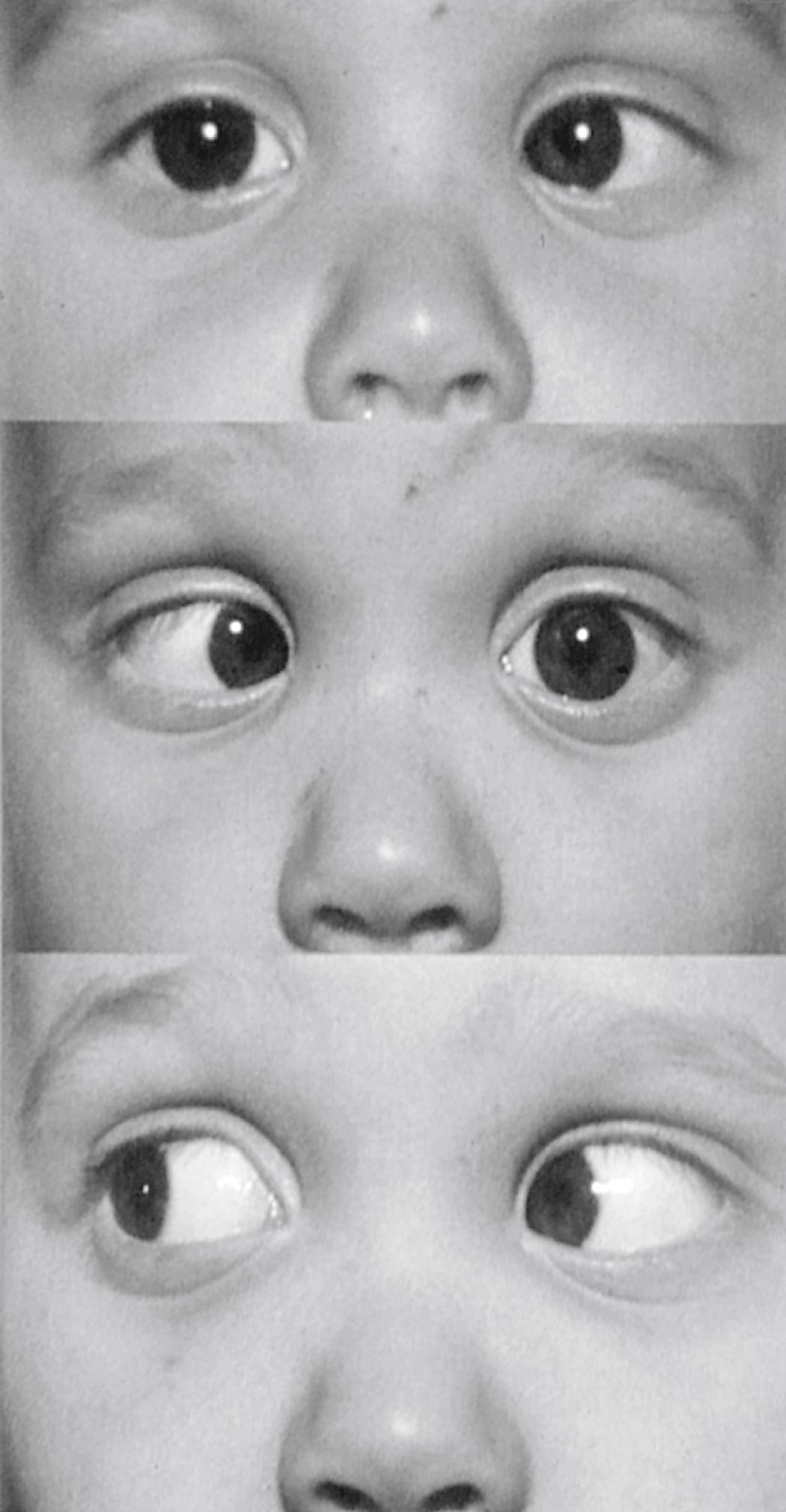
Infantile exotropia is much less common than infantile esotropia. Infantile exotropia presents as a large deviation of the eyes prior to 6 months of age. Infantile exotropia is uncommon in otherwise healthy infants. It is, however, commonly associated with craniofacial disorders or neurologic impairment. Surgery may be done early in life, but these patients are less likely to obtain good binocular vision than infantile esotropia.
Intermittent exotropia is the most common type of exotropia. This usually manifests by 5 years of age. Parents will notice that the eyes deviate out at times and yet not at others. The deviation is most likely to occur when the child is tired or ill. Because the child maintains the ability to keep the eyes aligned part of the time, amblyopia is uncommon. Diplopia is prevented by active cortical suppression of input from the portion of the retina of the deviated eye that overlaps the central view of the fixating eye. When the eyes are straight, the child generally maintains normal binocular function, including stereopsis. The clinical management of intermittent exotropia is not clear. Treatment is not necessarily indicated as observation of children 3–11 years old shows that <15% of children are unlikely to develop a constant exotropia or amblyopia or lose stereopsis. Part-time patching, additional minus power spectacles in patients with myopia, and orthoptic exercises are treatment options, but there is insufficient evidence that these treatments are more effective than observation. For those patients whose control over an intermittent exotropia deteriorates, surgery can be offered.
Primary vertical strabismus is far less common than horizontal strabismus. A small vertical deviation (hypertropia or hypotropia) in association with a larger amount of horizontal strabismus, however, is common, and is managed in conjunction with the horizontal deviation. A common cause of hypertropia in children is congenital paralysis of the superior oblique muscle, a fourth cranial nerve paralysis. In some children, the “paralysis” is actually caused by an anatomic abnormality of the superior oblique tendon. Acquired causes of a superior oblique palsy include trauma, CNS abnormalities, or brain tumors. Children with a superior oblique paralysis of any cause frequently present with a head tilt and face turn toward the side opposite the paralyzed superior oblique muscle. If there is a question as to the timing of the onset of the superior oblique palsy, a review of pictures at a younger age may be helpful in determining chronicity. Superior oblique paralysis is one of the more common causes of ocular torticollis . An eye muscle disorder needs to be ruled out in any child with a chronic abnormality of head position. The anomalous head position and hypertropia caused by a superior oblique paralysis can be improved by eye muscle surgery in most instances. An approach to the evaluation of strabismus is noted in Fig. 43.9 , and less common forms of strabismus are listed in Table 43.3 .
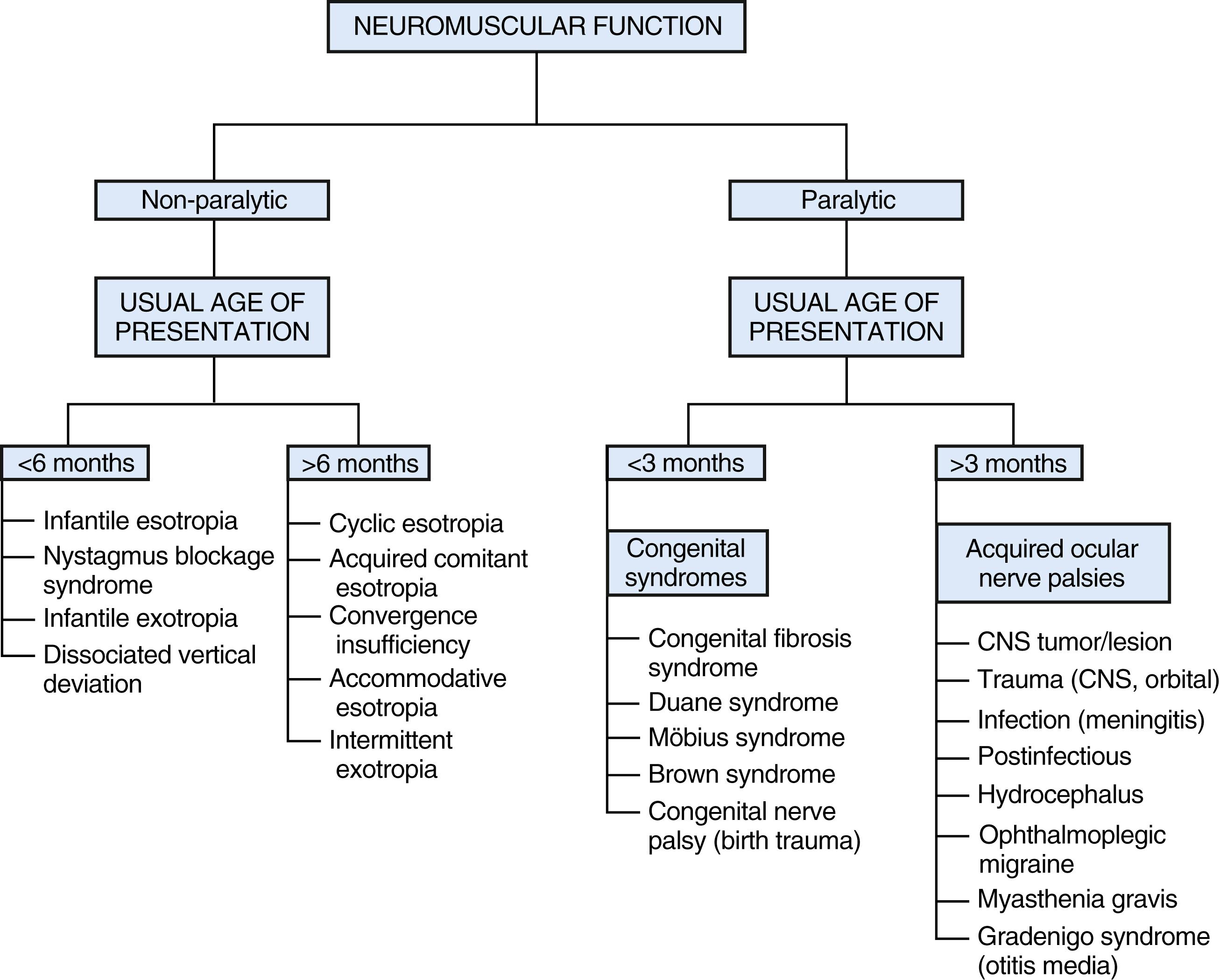
| Type of Strabismus | Presenting Symptoms and Signs | Cause | Treatment |
|---|---|---|---|
| Duane syndrome | Esotropia with deficient abduction or exotropia with deficient adduction of one eye; head turn | Absence of sixth nerve nucleus and aberrant innervation of lateral rectus muscle from third cranial nerve | Strabismus surgery for correction of large deviations or abnormal head position |
| Dissociated vertical deviation | One eye turns up intermittently, especially with fatigue | Eye movement abnormality related most commonly to congenital esotropia | Eye muscle surgery on superior rectus and inferior oblique muscles |
| Brown syndrome | Head tilt; inability to elevate eye in adduction | Restriction of free passage of superior oblique tendon through trochlea | Observation if not severe; superior oblique tendon surgery if severe |
| Möbius syndrome | Masklike facies; inability to abduct both eyes; difficulty closing eyes | Bilateral sixth and seventh nerve palsies | Protect corneas from exposure; strabismus surgery |
| Congenital fibrosis syndrome | Chin-up head position; inability to elevate eyes; ptosis | Autosomal dominant gene on chromosome 16 in some patients; superior division of third nerve in others | Surgical release of tight extraocular muscles |
| Third nerve palsy | Exotropia and hypertropia; ptosis; dilated, nonreactive pupil | Congenital absence of third nerve; trauma; tumor | Ptosis and strabismus surgery |
| Double elevator palsy | Chin-up head posture; inability to elevate one eye | Paresis of superior rectus muscle | Transposition strabismus surgery |
| Orbital floor fracture | Vertical diplopia; chin-up head position | Entrapment of orbital tissues in fracture | Repair of floor fracture; release of inferior rectus muscle restriction |
| Myasthenia: congenital or acquired | Variable ptosis and eye movement abnormalities | Blockage of acetylcholine receptor sites by immune complexes | Treatment of systematic myasthenia; strabismus surgery if patient is stable |
| Mitochondrial disorders | Ptosis, progressive external ophthalmoplegia, optic neuropathy, cardiomyopathy, peripheral myopathy | Various mitochondrial variants | Supportive |
Refractive errors include myopia (nearsightedness), hyperopia (farsightedness), and astigmatism. Refractive errors may be similar (isometropia) or different (anisometropia) between the two eyes. Bilateral amblyopia may result from a high refractive error that is isometropic. Full-time spectacle correction will often correct bilateral amblyopia. Unilateral amblyopia may result from anisometropia. Patching or atropine penalization may be necessary in these children.
In patients with myopia (nearsightedness), the parallel rays of light in the resting (nonaccommodating) eye are focused in front of the retina. The symptoms of myopia are squinting, holding or viewing an object more closely than normal, and complaining of blurred far vision.
The incidence and degree of myopia increase with age, especially during growth spurts, as in adolescence. There is a complex interaction between genetic and environmental factors in the development of myopia. The incidence of myopia varies with ethnicity and geographic regions and has been increasing in prevalence over the past 50 years. There have been several genetic markers linked to myopia, but the increasing frequency among younger generations suggests environment plays an important role. The increase in prevalence from 10% to 90% in some populations is a public health concern, particularly with high myopia. Myopia can be associated with increased risk of retinal detachment, early cataract, and glaucoma. In very high myopia there can be thinning of the retina and retinal degeneration. This can result in decreased vision even with spectacle or contact lens correction. A promising strategy to slow the progression of myopia is application of a dilute formulation of atropine. Increasing the time spent outdoors appears to slow progression.
Myopia may be associated with other ocular abnormalities, such as keratoconus (central conical protrusion of the cornea), cataracts, ectopia lentis (dislocated lens), spherophakia (overly spherical lens), glaucoma, and medullated (myelinated) nerve fibers. There is an increased prevalence of myopia in premature infants, especially with ROP (retinopathy of prematurity). Children with high degrees of myopia may have an underlying systemic association, such as Marfan, Stickler, Noonan, or Down syndrome. If myopia is sufficient to produce visual symptoms, spherical concave (minus) lenses in the form of spectacles or contact lenses are prescribed to correct the refractive error. Prescription changes may be needed every 1–2 years and more often during growth spurts.
In patients with hyperopia (farsightedness), parallel rays of light in the nonaccommodating eye would be focused behind the retina. The process of accommodation (focusing), which alters the shape of the lens, can compensate for some degrees of hyperopia. Because most children have a tremendous range of accommodation, mildly hyperopic children can see clearly without any visual symptoms. Moderate to severely hyperopic children may be unable to fully compensate through accommodation. The greater accommodative effort may lead to symptoms of “eyestrain,” which consist of headaches, fatigue, or eye rubbing. These symptoms may lead to a lack of interest in reading or in prolonged close work. Some children may also develop accommodative esotropia. Some children have a decreased ability to accommodate, or accommodative insufficiency, and are symptomatic even with low degrees of hyperopia. If hyperopia produces symptoms, decreases vision, or causes esotropia, spherical convex (plus) lenses usually in the form of glasses are prescribed to correct the refractive error.
In astigmatism, the refractive power differs in various meridians of the eye. In most cases, astigmatism is caused by abnormal curvature of the cornea; although rare, lens abnormalities or dislocation may cause astigmatism. Infants and children with corneal distortion secondary to scarring (trauma or infection) or to external compression (neurofibroma or hemangioma of eyelid) are at an increased risk for astigmatism. Moderate levels of astigmatism may produce blurring of vision (far and near), leading to squinting, fatigue, headaches, and lack of interest in close-up work in older children and amblyopia in younger children. Cylindric or spherocylindric lenses (usually glasses) are used to improve vision and comfort.
In patients with anisometropia, the refractive error of one eye differs significantly from that of the other eye. The difference in refraction can be spherical (hyperopia or myopia) or cylindric (unequal amounts of astigmatism). Mild degrees of anisometropia usually cause no visual symptoms and do not lead to amblyopia. Amblyopia develops with higher degrees of anisometropia because the child uses the less ametropic eye and suppresses vision in the other. Strabismus frequently coexists with anisometropia, and both conditions may be involved in the pathophysiologic mechanisms of amblyopia. Anisometropia may initially be detected by comparison of the red reflex between the two eyes (Brückner test). The affected eye has the duller red reflex. Early detection and treatment of anisometropia are essential for the development of optimal visual function.
Vision impairment is formally defined as best-corrected visual acuity of 20/70 or worse in both eyes. Impairment of vision exists as a continuum from 20/70 to no light perception. Unrestricted, noncommercial driver’s license has a requirement of best-corrected vision of 20/40 or better in most states. Legal blindness is said to be present when best-corrected visual acuity is 20/200 or less in each eye. Constricted visual fields may also play a role in the diagnosis of vision impairment or legal blindness. An infant or child whose visual acuity and visual field cannot be quantitated may be judged visually impaired on the basis of inability to fixate on and follow movement of the examiner’s face or other objects or, in severe instances, inability to perceive light. Milder vision impairment may be suspected on the basis of associated eye signs but can be difficult to confirm in a preverbal child because of compensatory behavior (holding objects close, a face turn) that allows the child to have relatively normal overall function and development. Observation of the child’s behavior in the examination room, examination of the eyes ( Table 43.4 ), and a detailed history ( Table 43.5 ) taken from the parents about the child’s visual behavior at home can be important in establishing the degree of impairment. Many visually impaired infants and children have objective signs such as nystagmus, sluggish pupillary light reflexes, or anatomic abnormalities such as optic nerve hypoplasia or chorioretinal scarring. Visual evoked potential (VEP) and electroretinogram (ERG) can help delineate optic nerve or retina pathology, respectively.
| Physical Findings | Possible Pathologic Process |
|---|---|
| Inspection | |
| Globe | |
|
High hyperopia, persistent hyperplastic primary vitreous, phthisis bulbi (shrinkage related to deteriorating eye disease) |
|
Glaucoma, high myopia |
|
Inflammatory disease (infection, uveitis), trauma, tumor, glaucoma |
|
Retrobulbar or orbital infection/tumor, hyperthyroidism, nonspecific orbital inflammation (orbital pseudotumor), sarcoidosis |
|
Orbital fracture, Horner syndrome, atrophy, microphthalmia |
|
Impairment of extraocular muscles: congenital weakness, muscle entrapment (tumor/trauma), cranial nerve palsy (infection, tumor, stroke, congenital) |
| Ophthalmoscopy | |
| Cloudy cornea | Anterior segment dysgenesis (Peter anomaly), glaucoma, trauma, infection, metabolic storage diseases (mucopolysaccharidoses) |
| Lens | |
|
Cataracts (congenital vs systemic diseases) |
|
Homocystinuria, Marfan syndrome |
|
Retinoblastoma, detached retina, endophthalmitis, uveitis, hemorrhage |
| Optic disk | |
|
Optic atrophy (congenital, trauma, tumor, hydrocephalus, degenerative neurologic disease) |
|
Increased intracranial pressure, optic neuritis |
|
Optic neuritis, increased intracranial pressure |
| Retina/choroid | |
|
Retinitis pigmentosa (spicule pattern), chorioretinitis (atrophy with hyperpigmentation), Tay-Sachs disease (cherry-red macula), albinism |
|
Diabetes mellitus, Coats disease, increased intracranial pressure, sickle cell, arteriovenous malformations |
|
Hypertension, diabetes mellitus, increased intracranial pressure, trauma, blood disorders |
|
Tuberous sclerosis (yellow plaques, nodules), von Hippel–Lindau disease (reddish globular mass), Sturge-Weber syndrome (choroidal hemangioma), neurofibromatosis (yellow plaques) |
| Blood vessels | |
|
Hypertension |
|
Diabetes mellitus |
|
Retinal vasculitis |
| Manifestation | Possible Pathologic Process |
|---|---|
| Child’s Complaint | |
| Generalized blurred vision | |
|
Myopia |
|
Hyperopia, disorder of accommodation |
|
Astigmatism or defect of visual pathways |
| Focal blurred vision (veil, shadow) | |
|
Ipsilateral retinal or optic nerve |
|
Chiasmal, postchiasmal, or bilateral prechiasmal lesion |
| Ghost/double vision | |
|
Cranial nerve or extraocular muscle |
|
Ocular media or macular disease |
| Changes in special visions | |
|
Retinal or optic nerve disease |
|
Retinal disease (retinitis pigmentosa), congenital stationary night blindness, vitamin A deficiency |
| Visual sensations | |
|
Uveitis, retinal detachment, or hemorrhage |
|
Migraines |
|
Cerebral lesion, psychogenic, autoimmune encephalitis |
| Parents’ Observations | |
| Age-appropriate infant does not track | Severe ocular (myopia, cataracts) or systemic (meningitis) pathologic process |
| Objects viewed too closely | Decreased visual acuity related to refractive error; ocular or neurologic disorder |
| Squinting | Decreased visual acuity related to refractive error; ocular or neurologic disorder |
| Roving or wandering eyes | Nystagmus or strabismus; rule out ocular or neurologic disorder |
| Head tilting | Compensatory posturing for nystagmus, strabismus, astigmatism, or visual field defect |
| Bumping into objects | Visual field defect, decreased visual acuity |
| Reading problems | Visual impairment, visual processing disorder |
Visual inattentiveness in an infant deserves special attention because of the possibility that the child has a treatable but not obvious form of vision impairment such as bilateral congenital cataracts. Even if the cause of impairment is not remediable, early diagnosis is important for referral of the infant for physical and occupational therapy for visual impairment since these children have very specific needs. Vision impairment (monocular or binocular) acquired after infancy obligates the physician to search for a cause such as a retinal degeneration because some causes are treatable ( Tables 43.6, 43.7, and 43.8 ).
| Congenital Malformations |
|
| Phakomatoses |
|
| Tumors |
|
| Neurodegenerative Diseases |
|
| Infectious Processes |
|
| Hematologic Disorders |
|
| Vascular and Circulatory Disorders |
| Trauma |
|
| Drugs and Toxins |
∗ Coats disease: poor vision, leukocoria, retinal telangiectasia, and exudation.
† Susac syndrome: branch retinal artery occlusions, hearing deficits, central nervous system dysfunction.
| Disorder | Timing | Pattern of Loss | Other Clues | Fundus Appearance | Pupil |
|---|---|---|---|---|---|
| Refractive error | Gradual ∗ | Varies | Improves with pinhole | Normal | Normal |
| Cataract | Very gradual | Tunnel? | Opacity visible | Normal | Normal, but red reflex decreased |
| Corneal disease | Acute or chronic | Murky | Opacity visible or positive fluorescein | Normal | Normal, but red reflex decreased |
| Iritis | Acute or chronic | Murky | Pain Ciliary flush |
Normal | Small Disfigured? |
| Open-angle glaucoma | Gradual | Varies | Elevated pressures | Normal | Normal |
| Angle-closure glaucoma | Acute | Varies | Pain Steamy cornea Patient ill |
Normal | Dilated Fixed |
| Central retinal occlusion | Acute | Varies | Painless Abrupt |
Pale with cherry-red macula | Normal |
| Retinal detachment | Acute | Varies | Painless Floaters |
Unremarkable or diagnostic | Afferent pupillary defect if extensive |
| Vitreous hemorrhage | Acute | “Dark” | Cannot see in the eye | Obscured | Normal, but red reflex decreased |
| Amaurosis fugax | Acute Transient |
5–10 min | Carotid or heart disease, migraine | Normal | Normal |
| Migraine | Acute Transient |
5–30 min | Headache History Scintillations |
Normal | Normal |
| Optic neuropathy, neuritis | Gradual or acute | Central scotoma | Decreased visual acuity, loss of color vision, pain on eye movement, may also have spinal cord lesion | Normal Pale optic disk? |
Afferent defect |
| Diffuse retinopathy | Gradual | Varies | Genetic AIDS |
Retinal lesions | Afferent defect? |
| Papilledema (chronic) | Late | Varies | CNS tumor Pseudotumor cerebri Hypertensive crisis |
Diagnostic; optic atrophy | Normal |
| Endophthalmitis | Varies | Varies | Corneal, systemic infection Penetrating injury Systemic inflammation or injury Hypopyon |
Varies Often obscured |
Varies |
∗ Refractive error may be more acute when caused by diabetes mellitus.
| Condition | Physical Findings | Comments |
|---|---|---|
| Corneal Disease | ||
| Corneal forceps injury | Cloudy cornea | May lead to astigmatism and amblyopia; associated with intraocular hemorrhage, retinal detachment |
| Sclerocornea | Opaque cornea | Scleralization of cornea; familial or sporadic; keratoplasty possibly needed to provide vision |
| Anterior microphthalmia | Small cornea | Familial inheritance; associated with congenital cataracts, glaucoma, and/or coloboma |
| Anterior Chamber Diseases | ||
| Peter anomaly | Corneal opacity with iridocorneal/lenticulocorneal adhesions | Maldevelopment of anterior segment of eye; associated with glaucoma and lens abnormalities |
| Persistent pupillary membrane | Bands or membranes obscuring pupil | Rupture of vessels in membranes may lead to hyphema; membrane may need to be removed to restore vision |
| Glaucoma | Tearing, enlarged eye, photophobia, cloudy cornea, pale optic disk | Increased intraocular pressure leading to blindness (optic nerve damage) Causes: anomalies of anterior segment, intraocular hemorrhage, ocular inflammatory disease, intraocular tumors Treatment: surgery |
| Iris and Lens Disorders | ||
| Aniridia | Large, irregular, unreactive pupil | Hypoplasia of iris—may be heritable or sporadic, which is associated with a deletion of chromosome 11 and Wilms tumor or WAGR syndrome |
| Cataracts | Lens opacity | Multiple causes, ranging from familial inheritance to drugs |
| Anterior PHPV | Leukocoria (white pupillary reflex), lens opacity, cloudy cornea, small lens and eye | Persistence of fetal hyaloid vascular system, resulting in fibrovascular plaque on back of lens; as plaque contracts, ciliary process and lens become distorted Complications: glaucoma, cataract, intraocular hemorrhage, rupture of posterior capsule Treatment: removal of membrane, lens aspiration Prognosis: poor visual outcome |
| Retinal and Optic Nerve Disorders | ||
| Posterior PHPV | Fibroglial veils around disk/macula, vitreous opacities (membrane, vessels) | Persistence of posterior fetal hyaloid vascular system; remnants of vascular system may cause traction detachment of retina |
| Chorioretinitis | Diffuse or local retinal atrophy demarcated by hyperpigmentation | Inflammation of posterior uvea with retinal involvement Causes: toxoplasmosis, histoplasmosis, herpes simplex, cytomegalic inclusion virus, syphilis, tuberculosis, and toxocariasis Other complications: glaucoma, detached retina |
| Retinoblastoma | Leukocoria | Neoplastic tumor with locus on chromosome 13; high incidence of secondary malignancy; poor prognosis with extraorbital metastasis |
| Retinopathy of prematurity | Leukocoria, cloudy vitreous; retinal white lines and ridges | Abnormal vascularization of retina; associated with retinal traction and detachment |
| Leber congenital retinal amaurosis | Normal findings to degeneration of retina | Failure of both rods and cones in retina; reduced or absent response to electroretinography; autosomal recessive |
| Achromatopsia | Color cannot be detected, photophobia | Failure of cone system in retina; autosomal recessive, or X-linked; diagnosed with ERG |
| Congenital stationary night blindness | Disk anomalies, poor night vision | Defect in rod system of retina; autosomal recessive, dominant, or X-linked recessive |
| Optic nerve hypoplasia | Pale, small optic disk; peripapillary halo of pigmentation | Secondary to failure in differentiation or degeneration of retinal ganglion cell axons Some causes: septo-optic dysplasia (hypopituitary, midline CNS defects), chromosomal defects (trisomy 13), albinism, fetal drug exposure (phenytoin, ethanol), infant of diabetic mother, CNS defects (hydrocephalus, anencephaly, encephalocele) |
| Optic nerve aplasia | Absence of retinal vessels and optic disk | Maldevelopment of optic nerve; associated with severe eye and CNS anomalies |
| Morning glory disk anomaly | Enlarged, funnel-shaped disk | Associated with retinal detachments and midline defects (cleft palate, encephalocele, agenesis of corpus callosum) |
| Coloboma | White, wedge-shaped retinal defect; visual field loss | Malclosure of embryonic fissure that leaves a gap in the retina, hence exposing sclera; defect may extend to lens; associated with many congenital syndromes |
| Aicardi syndrome | Retinal lacunae, coloboma of optic disk | Occurs mostly in females; associated with agenesis of corpus callosum, seizures, intellectual disability, vertebral anomalies |
| Albinism | Photophobia; blue-gray to yellow-brown iris; macular hypoplasia | Defect in formation of melanin, resulting in lack of pigment in eyes and sometimes skin; increases risk of skin cancer with hypopigmented skin |
Optic neuropathies may be isolated or part of a broader multisystem disease. Leber hereditary optic neuropathy, a mitochondrial disorder, presents with subacute and severe vision loss ( Table 43.9 ). Other mitochondrial disorders with optic atrophy include Leigh syndrome and myoclonus epilepsy with ragged-red fibers (MERRF) syndrome. Hereditary neuropathies (Charcot-Marie-Tooth, familial dysautonomia, spinocerebellar ataxia, Friedreich ataxia), some leukodystrophies, and lipidosis are also associated with optic neuropathy.
| OPA1 | LHON | OPA3 | TMEM126A | WFS1 | |
|---|---|---|---|---|---|
| Inheritance | Autosomal dominant | Maternal | Autosomal dominant | Autosomal recessive | Autosomal dominant |
| Age of onset | Childhood | Young adult, male >> female | Late childhood | Childhood | Childhood to adult |
| Ophthalmologic features | Slowly progressive, tritanomaly | Sudden visual loss Frequently beginning unilateral | Often additional cataract | Early manifestation and progression | Highly variable |
| Loss of visual acuity | Moderate-severe | Pronounced visual impairment | Moderate | Severe visual loss | Variable |
| Possible extraocular signs | ∼20% of patients have neurologic symptoms (e.g., ataxia, neuropathy) | Mild neurologic symptoms possible; multiple sclerosis–like symptoms | Late in life; mild neurologic signs possible late in life | Subclinical hearing impairment | Hearing impairment, disturbed glucose tolerance, behavioral abnormalities |
Premature infants are at risk for the development of ROP because the retinal vessels have not yet grown out to the periphery of the retina and are susceptible to a variety of postnatal influences, including oxygen that can adversely affect retinal vessel maturation. In advanced stages of ROP, retinal neovascularization and fibrosis may lead to traction on the retina and result in a retinal detachment, the most common cause of blindness in premature infants. In most cases, fortunately, ROP spontaneously resolves.
The international classification system for the acute stages of ROP describes the location, extent, and stage of the disease according to the position of the advancing wave of retinal vessels ( Fig. 43.10 ). The retina is divided into zones I, II, and III. Zone I is centered on the optic nerve, from which the retinal arterioles emerge, and zone III exists as a crescent of retina on the temporal side; zone II occupies the midportion of the retina in all four quadrants. The severity is indicated by stages 1–5, with stage 1 representing mild ROP and stage 5 representing a total retinal detachment.
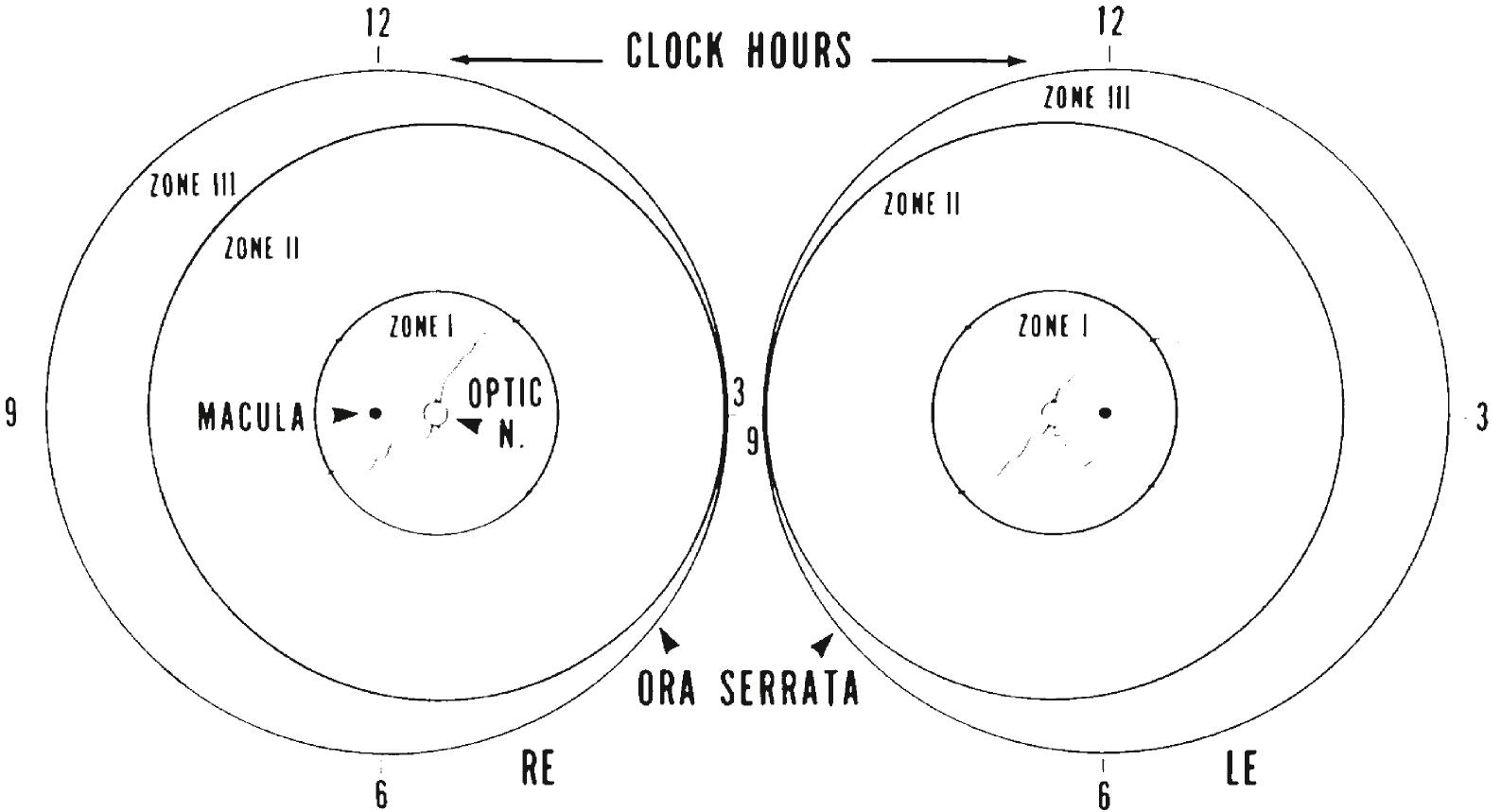
The management of ROP begins with a systematic program of eye examinations at well-defined times in infants judged to be at risk for developing ROP. The frequency of examinations is dependent on the findings and progression of the disease. Infants with a birthweight of <1,500 g are first examined 4–6 weeks after birth. Follow-up examinations are performed at regular intervals until the retina is fully vascularized. If treatment is required, laser ablation of immature retina or intravitreal injections of anti–vascular endothelial growth factor (VEGF) medication such as bevacizumab are options. The choice of treatment depends on the zone and the rate of progression of disease. Insulin-like growth factor (IGF)-1 supplementation or alterations may be a means to prevent ROP in the future.
Leukocoria or “white pupil” is a sign, not a specific disease ( Table 43.10 ). True leukocoria mandates prompt referral to an ophthalmologist as the causes may threaten either vision and/or life. Retinoblastoma is the most feared cause of leukocoria because of its potential to metastasize and cause death. It is the most common malignant ocular tumor of childhood, with an incidence of about 1/15,000. Leukocoria, the most common presenting sign, is caused by light reflection from the tumor’s white surface ( Fig. 43.11 ) as opposed to the usual red reflex from the retina. Approximately 25% present with strabismus. Less common presentations include periocular inflammation, glaucoma, and proptosis. Imaging is helpful to evaluate for calcifications that occur in retinoblastoma and to help confirm the diagnosis as well as to evaluate for pinealoblastoma and extension of the tumor into the orbit. MRI should be done because CT scan poses concern for radiation exposure and the development of secondary cancers, for which patients with retinoblastoma are at increased risk. Referral of a patient with suspected retinoblastoma to an ophthalmologist experienced in its diagnosis and management is critical. Genetic counseling is indicated, as is examination of parents and siblings. In about 1% of cases a parent will have a regressed retinoblastoma or retinocytoma. Treatment options are focused on vision-sparing therapies including ophthalmic artery chemosurgery, laser photocoagulation, cryotherapy, intravitreal chemotherapy, systemic chemotherapy, and enucleation depending on laterality, location, extent of tumor, and vision potential. There is concerted effort to save the globes through advances in therapies, and in most cases, this can be achieved.
| Common Causes |
|
| Other Causes |
|
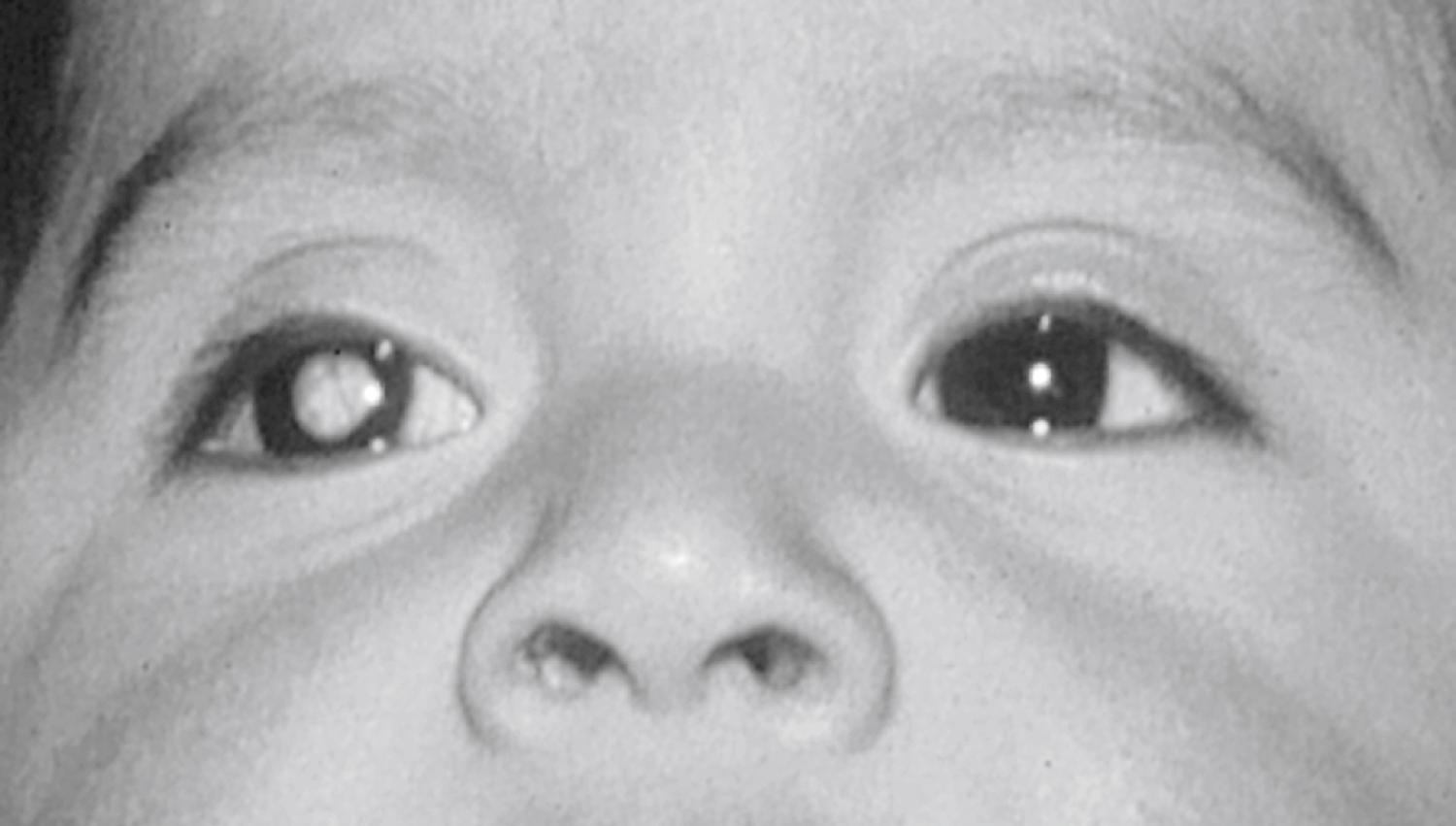
Congenital cataracts are a common cause of unilateral or bilateral vision loss in children, usually resulting from irreversible amblyopia in one or both eyes and occasionally from other accompanying structural ocular abnormalities ( Table 43.11 ). Many infants with cataracts have leukocoria, but all visually significant cataracts can be detected by careful evaluation of the red reflex ( Figs. 43.12 and 43.13 ). Infants with bilateral, visually significant cataracts may present with visual inattentiveness or nystagmus, signs that significant impairment of vision has already occurred.
| Developmental Variants |
|
| Genetic Disorders |
| Simple Mendelian Inheritance |
|
| Major Chromosomal Defects |
|
| Multisystem Genetic Disorders |
|
| Inborn Errors of Metabolism |
|
| Endocrinopathies |
|
| Congenital Infections |
|
| Ocular Anomalies |
|
| Miscellaneous Disorders |
|
| Idiopathic |
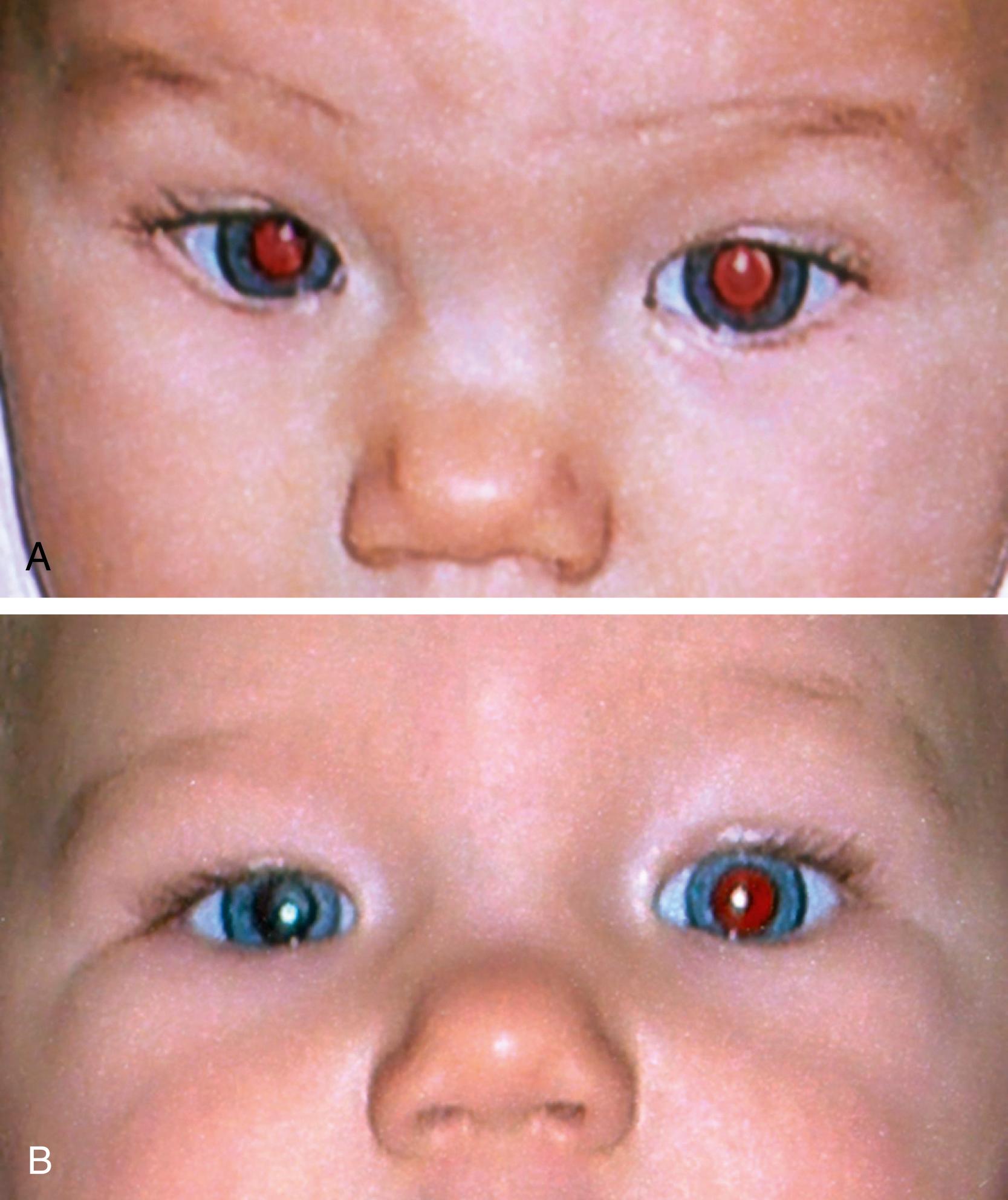

Most cases of unilateral cataract are idiopathic in origin or associated with other ocular anomalies (persistent hyperplastic primary vitreous, anterior segment dysgenesis). Bilateral cataracts have a known genetic basis in about 60–70% of the cases, but this is increasing as novel pathologic genetic variants continue to be described. Cataracts are commonly inherited in an autosomal dominant manner but may be inherited in an autosomal recessive or X-linked pattern. They can be associated with metabolic disease such as galactosemia or Fabry syndrome. Cataracts found to be a result of a metabolic disease may be reversible by removal of the offending agent; galactosemic cataracts are potentially reversible if lactose is eliminated from the diet promptly. Intrauterine TORCH(S) infections ( t oxoplasmosis, r ubella, c ytomegalovirus, h erpes simplex, and s yphilis) can also cause cataracts. Usually these are bilateral but in the case of congenital rubella infection unilateral cataract may occur. Evaluation for a systemic cause should include a pediatric physical examination, ophthalmologic examination of the infant and family members, urine for reducing substances after lactose-containing milk feeding, and labs for TORCH infections, calcium, phosphorus, and glucose. Other metabolic studies, chromosomal evaluation, and genetic consultation may be indicated.
Cataracts in older children may be newly acquired due to a metabolic disease, drug exposure such as steroids, or a manifestation of progressive congenital cataracts. Cataract may rarely be the initial manifestation of diabetes type 1 but can occur as a complication particularly in patients with poor glycemic control. Bilateral cataracts are often the presenting sign in patients with unrecognized cerebrotendinous xanthomatosis (CTX). These patients usually have had chronic diarrhea without a known cause. Unfortunately, CTX is often diagnosed late after mental and neurodegeneration has started to occur. Since chenodeoxycholic acid can be used to prevent mental and neurologic deterioration, CTX should be considered in the presence of a juvenile-onset cataract and chronic diarrhea. Occasionally cataracts, unilateral or bilateral, are caused by an underlying congenital lens defect, which develops into a visually significant cataract at a later age. Trauma is a common cause of an acquired unilateral cataract.
Ideally, unilateral cataracts must be removed, and amblyopia treatment begun in the first or second month of life. Bilateral cataracts judged to be visually significant must be treated in the first 3 months of life to facilitate an optimal outcome. After this critical period maximum visual potential is decreased. Aphakic correction in infants younger than 6–12 months with bilateral cataracts is generally provided with extended-wear contact lenses or spectacles. Unilateral aphakia in this age group is best managed with a contact lens. A posterior chamber intraocular lens may be placed in children over the age of 1 year unless the child has an underlying inflammatory condition such as juvenile idiopathic arthritis (JIA). An intraocular lens may be placed in a child with a traumatic cataract if the intraocular structures that support the lens are intact. The management of a cataract goes well beyond cataract surgery. Amblyopia must be treated with occlusion of the sound eye, often for several years, until stable visual acuity can be demonstrated. Most children (80%) will develop strabismus by age 5 years. Those who have had cataract surgery must be monitored indefinitely to evaluate for delayed complications such as glaucoma and retinal detachment.
Pediatric glaucomas result from abnormalities of the aqueous outflow pathways (primary congenital glaucoma) or abnormalities that affect other parts of the eye (secondary glaucoma) ( Table 43.12 ). Several genes causing primary congenital glaucoma, usually autosomal recessive, have been identified. Primary congenital glaucoma is bilateral in about 65% of patients. This presents as a classic triad consisting of blepharospasm, photophobia, and epiphora ( Fig. 43.14 ). The cornea may be cloudy due to edema resulting from elevated intraocular pressure. The cornea also enlarges and the axial length of the eye may increase with elevated intraocular pressure. Onset usually occurs in the first year of life, but only 25% are present at birth. If glaucoma presents after the age of 5 years, it is known as primary juvenile open-angle glaucoma. The natural history of untreated primary congenital glaucoma is blindness resulting from progressive corneal opacification and optic nerve damage. Treatment is surgical, although eye pressure–lowering medications such as topical β blockers and topical or oral carbonic anhydrase inhibitors may be used as temporizing measures. Even with treatment, final visual acuity is worse than 20/50 in more than 50% of the patients.
| Primary Childhood Glaucoma | Secondary Childhood Glaucoma—cont’d
|
Juvenile open-angle glaucoma |
|
| Secondary Childhood Glaucoma | |
Glaucoma Associated with Nonacquired Ocular Anomalies
Ectopia lentis et pupillaeGlaucoma Associated with Nonacquired Systemic Disease or SyndromeConditions predominantly with known syndromes, systemic anomalies, or systemic disease present at birth that may be associated with ocular signs:
|
|
| Glaucoma Associated with Acquired Condition | |
|
|
| Glaucoma Following Cataract Surgery | |
|
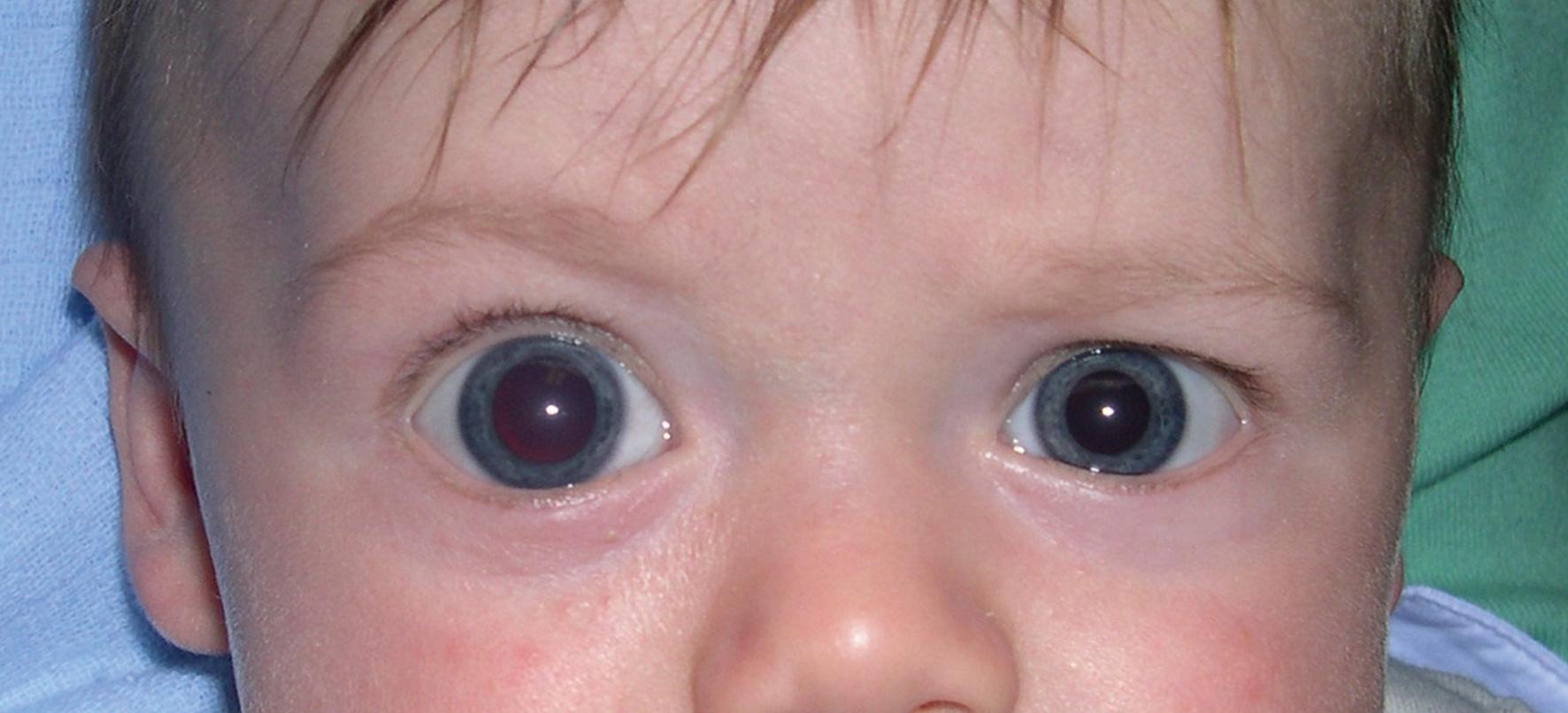
Secondary glaucoma may present similarly to primary glaucoma but is associated with other factors such as ocular trauma, inflammation, prolonged steroid use, or cataract. Some systemic conditions such as neurofibromatosis and Sturge-Weber syndrome are also associated with secondary glaucoma. The differential diagnosis of congenital glaucoma includes anterior segment dysgenesis and conditions that demonstrate corneal opacities ( Table 43.13 ) or an enlarged cornea ( Table 43.14 ). Epiphora also occurs with conjunctivitis, corneal trauma, and nasolacrimal duct obstruction (NLDO). Photophobia is observed in infants with corneal trauma, corneal deposits, cystinosis, and inflammation (uveitis). Corneal opacification can also be found in infants with corneal dystrophies, metabolic storage diseases such as mucopolysaccharidoses, and forceps-related obstetric trauma.
| Diagnosis | Laterality | Opacity | Ocular Pressure | Other Ocular Abnormalities | Natural History | Inheritance |
|---|---|---|---|---|---|---|
| S – Sclerocornea | Unilateral or bilateral | Vascularized, blends with sclera, clearer centrally | Normal (or elevated) | Cornea plana | Nonprogressive | Sporadic |
| T – Tears in endothelium and Descemet membrane | ||||||
| Birth trauma | Unilateral | Diffuse edema | Normal | Possible hyphema, periorbital ecchymoses | Spontaneous improvement in 1 mo | Sporadic |
| Infantile glaucoma | Bilateral | Diffuse edema | Elevated | Megalocornea, photophobia and tearing, abnormal angle | Progressive unless treated | Autosomal recessive |
| U – Ulcers | ||||||
| Herpes simplex keratitis | Unilateral | Diffuse with geographic epithelial defect | Normal | None | Progressive | Sporadic |
| Congenital rubella | Bilateral | Disciform or diffuse edema, no frank ulceration | Normal or elevated | Microphthalmos, cataract, pigment epithelial mottling | Stable, may clear | Sporadic |
| Neurotrophic – exposure | Unilateral or bilateral | Central ulcer | Normal | Lid anomalies, congenital sensory neuropathy | Progressive | Sporadic |
| M – Metabolic (rarely present at birth) (mucopolysaccharidoses IH, IS; mucolipidoses type IV) ∗ | Bilateral | Diffuse haze, denser peripherally | Normal | Few | Progressive | Autosomal recessive |
| P – Posterior corneal defect | Unilateral or bilateral | Central, diffuse haze or vascularized leukoma | Normal or elevated | Anterior chamber cleavage syndrome | Stable; sometimes early clearing or vascularization | Sporadic, autosomal recessive |
| E – Endothelial dystrophy | ||||||
| Congenital hereditary endothelial dystrophy | Bilateral | Diffuse corneal edema, marked corneal thickening | Normal | None | Stable | Autosomal dominant or recessive |
| Posterior polymorphous dystrophy | Bilateral | Diffuse haze, normal corneal thickness | Normal | Occasional peripheral anterior synechiae | Slowly progressive | Autosomal dominant |
| Congenital hereditary stromal dystrophy | Bilateral | Flaky, featherystromal opacities; normal corneal thickness | Normal | None | Stable | Autosomal dominant |
| D – Dermoid | Unilateral or bilateral | White vascularized mass, hair, lipid arc | Normal | None | Stable | Sporadic |
∗ Mucopolysaccharidosis IH, Hurler syndrome; mucopolysaccharidosis IS, Scheie syndrome.
| Anterior | Primary Infantile Simple Megalocornea | Megalophthalmos | Glaucoma with Buphthalmos |
|---|---|---|---|
| Inheritance | Autosomal dominant (?) | X-linked recessive (male preponderance) | Sporadic |
| Time of appearance | Congenital | Congenital | First year of life |
| Bilaterality | Bilateral | Bilateral | Unilateral or bilateral |
| Symmetric | Symmetric | Asymmetric | |
| Natural history | Nonprogressive | Nonprogressive | Progressive |
| Symptoms | None | None | Photophobia, epiphora |
| Corneal clarity | Clear | Clear or mosaic dystrophy | Diffuse edema, tears in Descemet membrane |
| Intraocular pressure | Normal | Elevated in some adults | Elevated |
| Corneal diameter | 13–18 mm | 13–18 mm | 13–18 mm |
| Corneal thickness | Normal | Normal | Thick |
| Keratometry | Normal | Normal; astigmatism | Flat |
| Gonioscopy | Normal | Excessive mesenchymal tissue | Excessive mesenchymal tissue |
| Globe diameter (A scan) | 23–26 mm | 23–26 mm | 27–30 mm |
| Major ocular complications | None | Lens dislocation; cataract, <40 yr; secondary glaucoma | Optic disk damage, late corneal edema |
| Associated systemic disorders | None | Occasionally Marfan and other skeletal abnormalities | None consistent |
The diagnosis of primary congenital glaucoma or secondary glaucoma is generally confirmed by performing an examination with the patient under anesthesia. The child needs to be quiet and very cooperative in order to get an accurate intraocular pressure reading and a careful examination of the cornea and anterior segment structures. The diagnosis rests on a constellation of abnormal ocular findings, including elevated intraocular pressure, corneal enlargement, increased axial length, anomalies of the drainage angle, and signs of damage to the optic nerve in conjunction with medical history.
Uveitis is defined as inflammation of the uveal tissue of the eye, which includes the iris, ciliary body, and choroid. Inflammation can involve any or all of these structures, and terms such as iritis ( Fig. 43.15 ), iridocyclitis, choroiditis, and chorioretinitis are used to designate which portion of the uveal tissue is involved. Anatomic location such as anterior, posterior, intermediate, or panuveitis or associated with meningitis is useful in determining etiology ( Table 43.15 ). Masquerade syndromes such as lymphoma or leukemia can mimic uveitis since they can have a leukocyte response that can be mistaken for inflammation.
| Anterior Uveitis |
|
| Intermediate Uveitis |
|
| Posterior Uveitis and Panuveitis |
|
| Uveo-Meningeal Syndromes |
|
JIA (juvenile idiopathic arthritis) is the most common cause of childhood anterior uveitis. JIA uveitis is most common in the pauciarticular form, when the onset occurs before the age of 7 years, and when the antinuclear antibody blood test is positive. Females are at higher risk than males; 10–15% of children with JIA develop uveitis and 10% of those who develop uveitis do so prior to the diagnosis of JIA. It is common for children with JIA to have no symptoms of inflammation in the eye. Despite the lack of symptoms, uveitis can cause severe vision loss due to the development of edema or deposition of calcium (band keratopathy) in the cornea or retinal edema ( Fig. 43.15 ). A cataract and/or glaucoma may result from inflammation in the eye or chronic use of steroids used to quiet the inflammation. The pupil may have an irregular shape as a result of adhesions to the underlying lens (posterior synechiae). Visual impairment occurs in up to 40% of children with JIA uveitis and blindness occurs in 10% of affected eyes. For this reason there are screening guidelines for the recommended frequency of eye exams based on the risk factors that predispose patients with JIA to uveitis including category of arthritis (oligoarthritis vs polyarthritis), age of onset of arthritis, presence of antinuclear antibody positivity, and duration of disease ( Fig. 43.16 ).
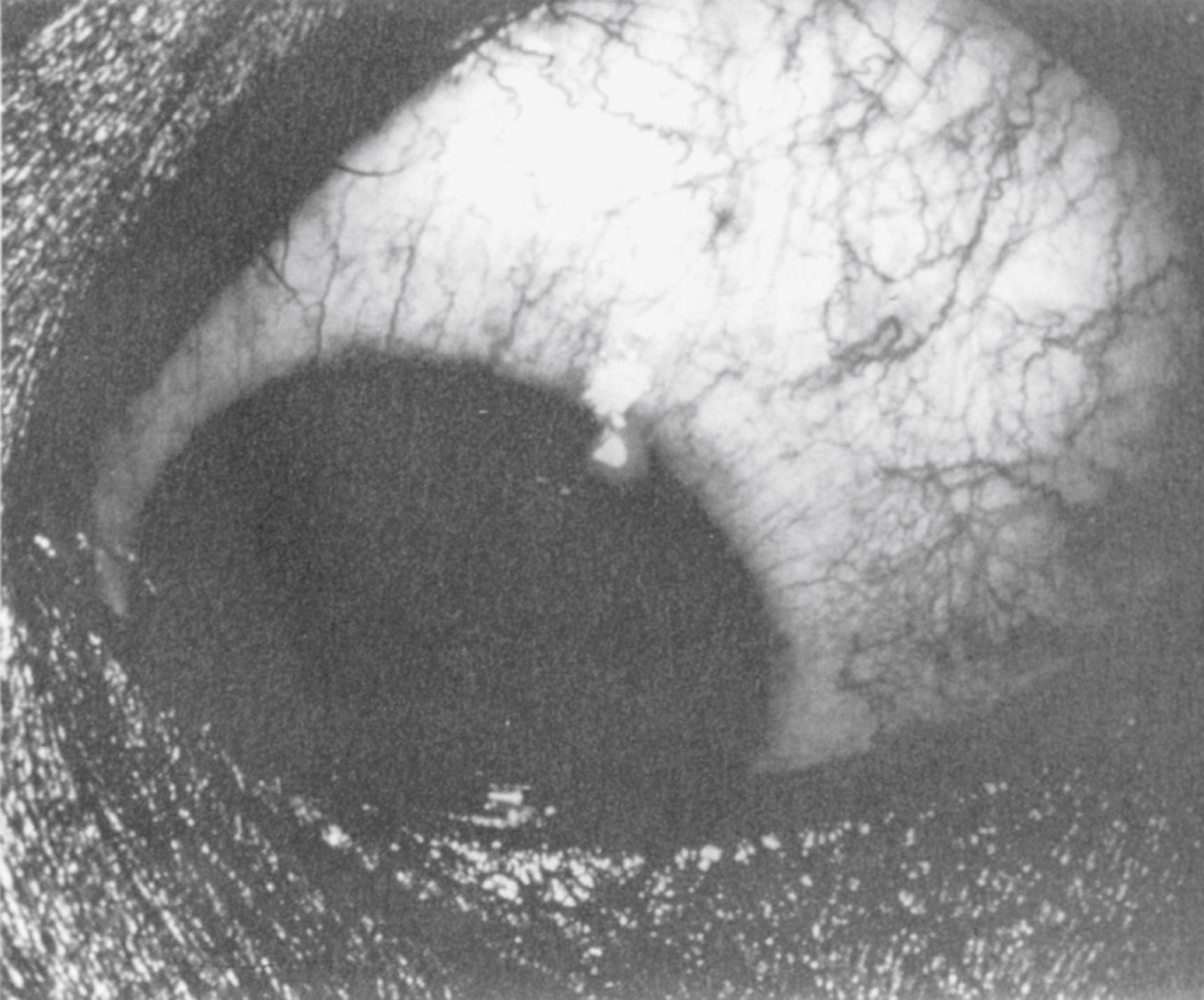
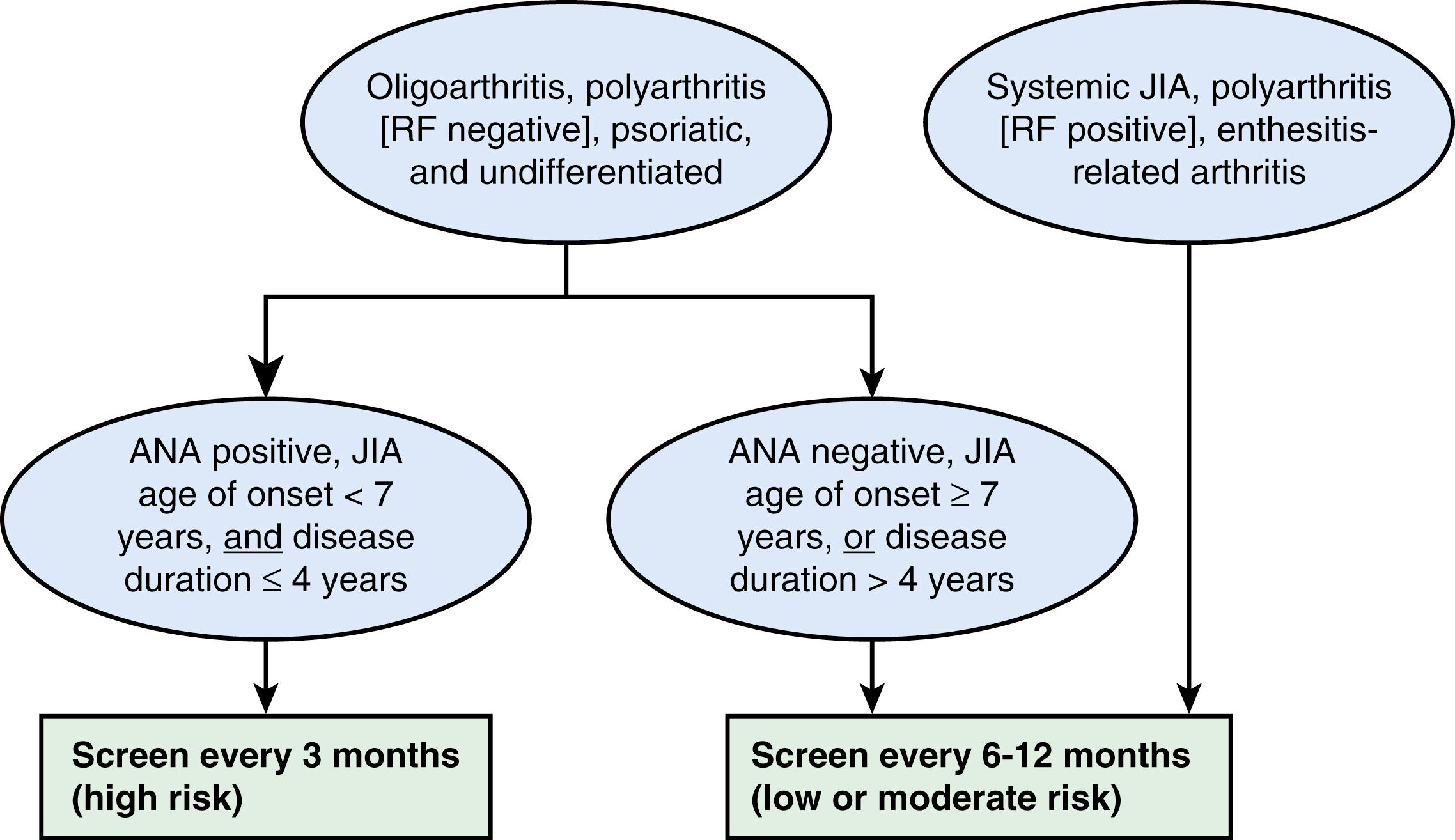
The diagnosis of uveitis can be made from an eye examination. Because uveitis can be caused by infections, trauma, or autoimmune disorders and often is idiopathic, evaluation of the cause of the uveitis requires a thorough pediatric physical examination as well as supplementary radiologic and laboratory testing. A chest radiograph may demonstrate tuberculosis and sarcoidosis. Serologic evaluation may include tests for syphilis, sarcoidosis, JIA, Lyme disease, herpes, measles, and toxoplasmosis. In males, haplotype testing for human leukocyte antigen B27 may be indicated because of the association between iritis and pauciarticular arthritis that may later evolve into ankylosing spondylitis.
The management of iritis in children is the elimination of intraocular inflammation. In some cases of noninfectious uveitis, local treatment with topical corticosteroid drops or periocular corticosteroid injections may control the inflammation. In many cases, local corticosteroids are not sufficient to control chronic uveitis. Immunomodulatory agents such as oral corticosteroids and corticosteroid-sparing agents, including nonsteroidal antiinflammatory drugs (NSAIDs), antimetabolites, T-cell inhibitors, alkylating agents, and antitumor necrosis factor biologic agents, are options. Short courses of corticosteroids may be used, but corticosteroid-sparing drugs are the first-line therapy for long-term use due to the many side effects of corticosteroids. Biologic agents are commonly used in severe disease or when the child has not responded to NSAIDs. Mydriatic drops are used to prevent the formation of posterior synechiae.
Toxoplasmosis caused by the intracellular parasite Toxoplasma gondii is the most common cause of posterior uveitis in children. Most ocular toxoplasmosis in the pediatric age group is probably acquired from the mother during pregnancy. In some instances, the infection is inactive at birth and goes unrecognized until inflammation occurs. Toxoplasmosis that is active at birth may result in widespread fetal tissue damage or may be associated with chorioretinitis, encephalomyelitis, and visceral disease. The diagnosis of toxoplasmosis is based on clinical findings, intracranial calcification in some children, and laboratory tests for specific immunoglobulin G (IgG) and immunoglobulin M antibodies. Isolated ocular toxoplasmosis does not require treatment unless it threatens vision. When treatment is indicated, it involves the use of one or more antimicrobial drugs. The most common therapy consists of combination therapy with pyrimethamine and sulfadiazine. Steroids may be given in combination with antibiotics. Intravitreal clindamycin with dexamethasone may be as effective as systemic therapies. Several other entities can simulate uveitis in children and must be considered. These entities include retinoblastoma, leukemia, lymphoma, juvenile xanthogranuloma, and an intraocular foreign body.
The nasolacrimal system consists of tear-secreting glands and a drainage system. The lacrimal gland, located in the superotemporal orbit, is the primary producer of tears; accessory lacrimal glands in the upper eyelid supplement its output. The lacrimal drainage apparatus begins with puncta on the nasal aspect of the upper and lower eyelid margins. The puncta continue as canaliculi that course nasally to empty into the lacrimal sac. The lacrimal sac in turn drains inferiorly through the nasolacrimal duct just under the inferior turbinate in the nose ( Fig. 43.17 ).
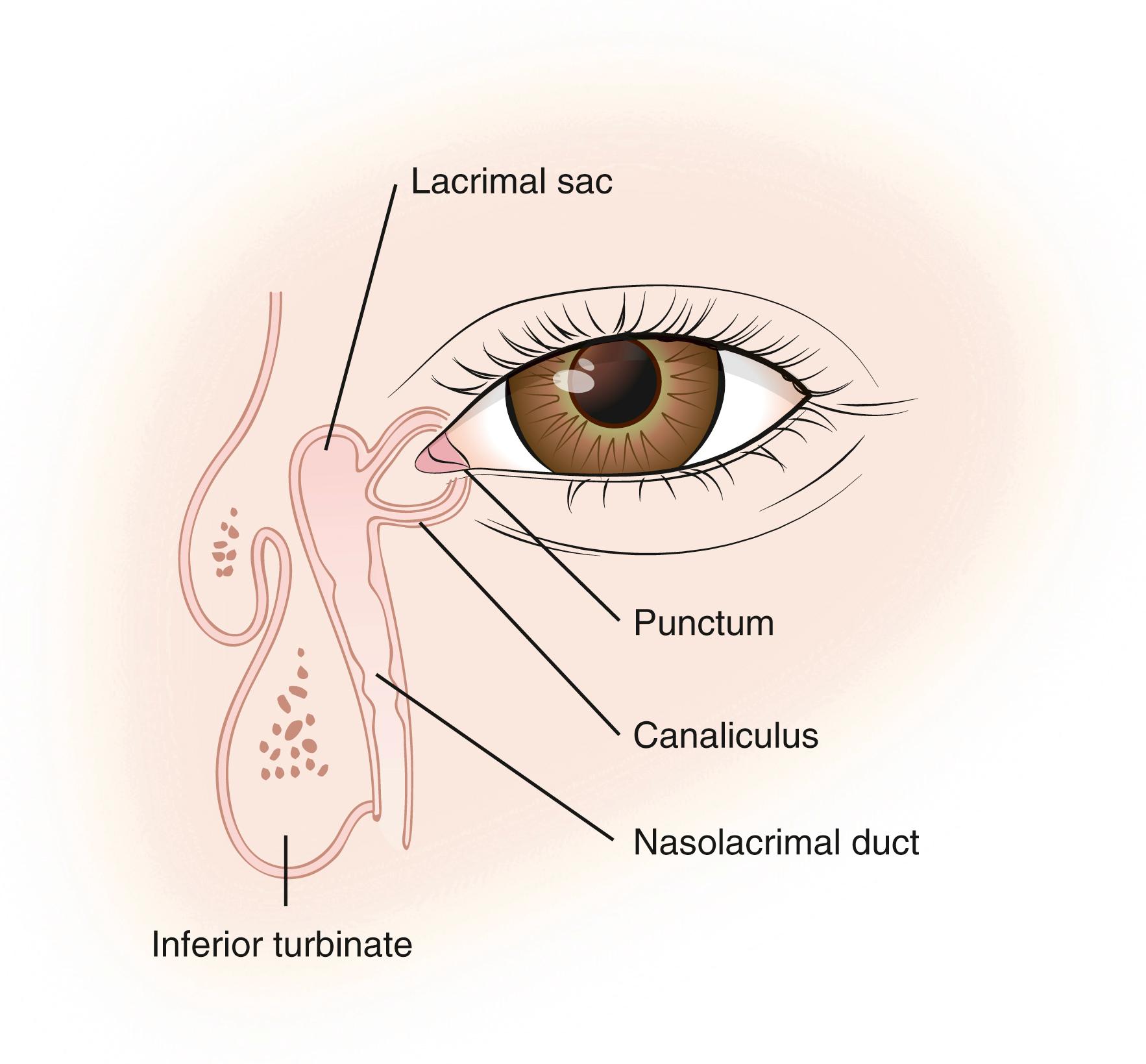
The most common developmental anomaly of the nasolacrimal drainage system is nasolacrimal duct obstruction (NLDO) , which occurs in up to 20% of infants. A thin mucosal membrane at the distal end of the duct, the valve of Hasner, is the most common cause of obstruction. Typically, the infant has epiphora and a mucopurulent discharge that causes matting of the eyelids beginning at about 1 month of age. Pressure applied to the lacrimal sac with a finger or cotton swab often results in reflux of cloudy fluid from the puncta. If infected, the source is usually polymicrobial, but a bacteriologic diagnosis is not necessary for clinical management. Eyelash washes with dilute baby shampoo can decrease the frequency of infections. Topical antibiotics can be used to decrease purulence, but this likely leads to resistant organisms. Recurrent infections may be considered an indication for early probing. Lacrimal sac massage may push fluid through the mucosal membrane and thereby open the duct, but the pressure applied to the lacrimal sac needs to be forceful. Most NLDOs will spontaneously resolve. If resolution does not occur within the first year of life, probing of the duct can be done and is effective in 90% of cases. Effectiveness of nasolacrimal duct probing decreases after the age of 18 months. A silicon stent can be placed temporarily to maintain an open duct, which increases the success of long-term patency.
NLDO must be differentiated from atresia of the puncta or canaliculi causing tearing but not infection and lacrimal-cutaneous fistula causing tears to drain to the skin surface. These conditions require surgery to re-form the canalicular system and puncta and repair the fistula if present. NLDO should be differentiated from infectious conjunctivitis, especially gonococcal, chlamydial, and herpetic infections. Chronic tearing also occurs in congenital glaucoma in addition to blepharospasm and photophobia.
A dacryocystocele is a variation of congenital NLDO that occurs in newborns. These infants present with a bluish mass in the naso-orbital region below the medial canthal tendon. This mass is a dilated lacrimal sac that has both distal obstruction from a membrane and proximal obstruction from a one-way valve effect from an incompetent valve of Rosenmüller ( Fig. 43.18 ). A hemangioma or dermoid cyst may have a bluish hue, but hemangiomas typically do not present at birth. An encephalocele or dermoid cyst may also appear to be a bluish mass but will lie above the medial canthus. On occasion, the dilated sac is accompanied by bulging of the nasal mucosa at the distal end of the nasolacrimal duct. The nasal mucocele can compromise the infant’s breathing. Imaging may help determine the location of the medial canthus in the presence of swelling, confirm the suspected diagnosis, and evaluate for the presence of a nasal mucocele, which is important for surgical planning. If the dacryocystocele fails to resolve with topical antibiotics and massage, or if cellulitis develops, systemic antibiotics and surgical decompression must be considered. Decompression is accomplished by relieving the distal obstruction by probing the nasolacrimal duct, removing any nasal cyst, and possibly placing a stent.
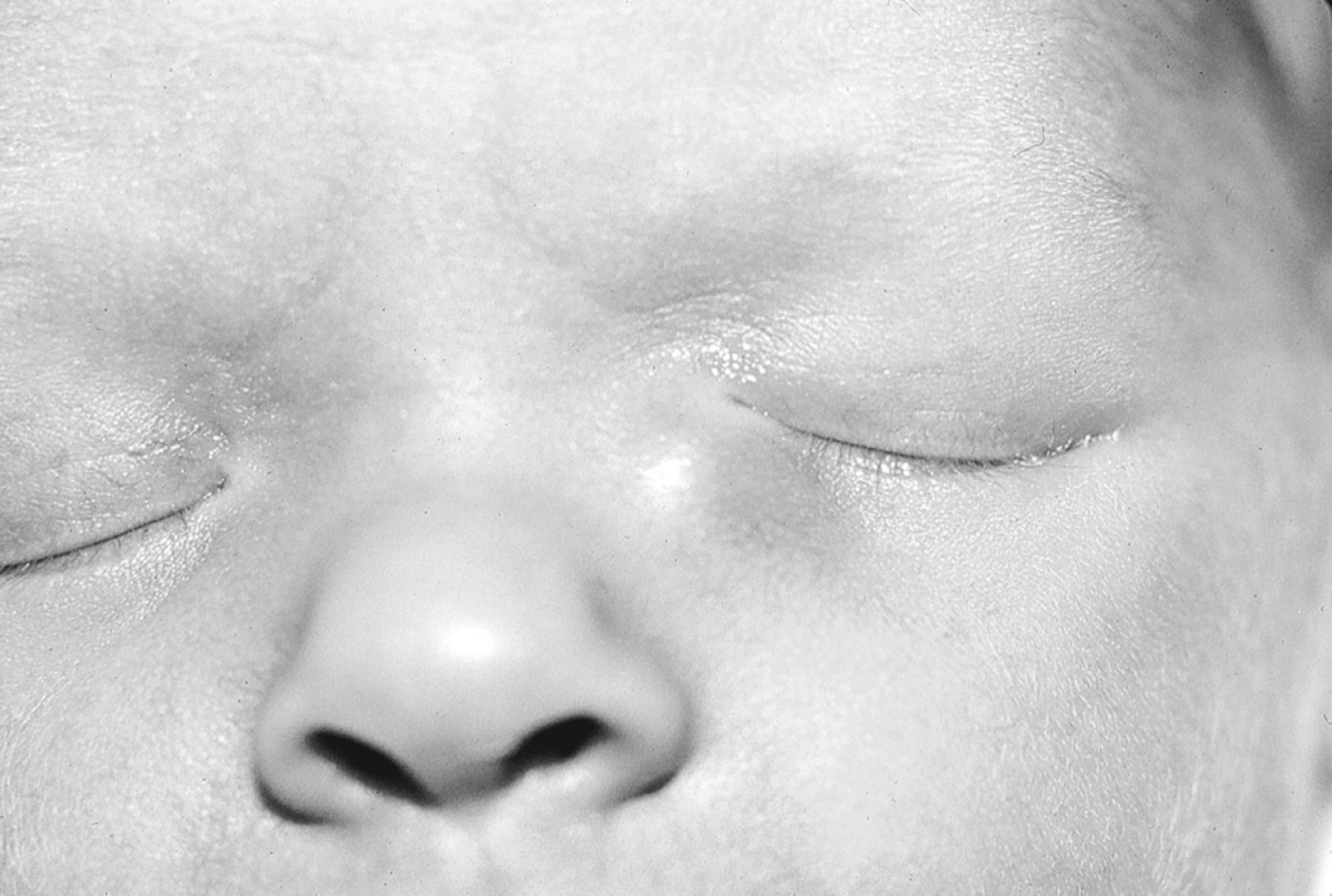
The term red eye usually refers to inflammation of the conjunctiva that causes the eye to appear red. Much less commonly (and much more seriously), the sclera is injected. Causes of red eye include infection of the ocular surface (cornea, conjunctiva, and sclera), allergy, intraocular inflammation, glaucoma, foreign body, and trauma. Evaluation must be directed toward discerning whether a child’s red eye is caused by a benign condition that will spontaneously resolve (viral conjunctivitis) or easily be treated with topical medication (bacterial conjunctivitis) or whether the cause is potentially vision threatening (iritis, corneal ulceration, glaucoma) and requires urgent ophthalmologic evaluation ( Table 43.16 ). Signs that should raise concerns for a serious etiology of red eye are in an immunocompromised host, severe pain, proptosis, limitation of eye movements, opacified cornea, abnormal pupil response, or lack of response to therapy.
| Condition | Cause | Signs/Symptoms | Treatment |
|---|---|---|---|
| Bacterial conjunctivitis | Haemophilus influenzae , H. influenzae aegyptius , Streptococcus pneumoniae , Neisseria gonorrhoeae , Staphylococcus aureus , Yersinia species, cat-scratch bacillus less common | Mucopurulent unilateral or bilateral discharge, normal vision, photophobia usually absentConjunctival injection and edema (chemosis); gritty sensation | Topical antibiotics: systemic ceftriaxone for gonococcus, H. influenzae |
| Viral conjunctivitis | Adenovirus, ECHO virus, coxsackievirus, herpes simplex virus, coronavirus | As above; may be hemorrhagic, unilateral enlarged preauricular lymph nodes | Self-limited |
| Neonatal conjunctivitis | Chlamydia trachomatis , gonococcus, chemical (silver nitrate), S. aureus | Palpebral conjunctival follicle or papillae; as above | Ceftriaxone for gonococcus and oral erythromycin for C. trachomatis |
| Allergic conjunctivitis | Seasonal pollens or allergen exposure | Itching, incidence of bilateral chemosis (edema) greater than that of erythema, tarsal papillae | Antihistamines, steroids, cromolyn |
| Keratitis | Herpes simplex, adenovirus, S. pneumoniae , S. aureus , Pseudomonas species, Acanthamoeba species, chemicals | Severe pain, corneal swelling, clouding, limbus erythema, hypopyon, cataracts; contact lens history with amebic infection | Specific antibiotics for bacterial/fungal infections; keratoplasty, acyclovir for herpes |
| Endophthalmitis | S. aureus , S. pneumoniae , Candida albicans , associated surgery or trauma | Acute onset, pain, loss of vision, swelling, chemosis, redness; hypopyon and vitreous haze | Antibiotics |
| Anterior uveitis (iridocyclitis) | JIA, reactive arthritis, sarcoidosis, Behçet disease, Kawasaki disease, inflammatory bowel disease | Unilateral/bilateral; erythema, ciliary flush (in circumcorneal area), irregular pupil, iris adhesions; pain, marked photophobia, small pupil, poor vision, no discharge | Topical steroids, plus therapy for primary disease |
| Posterior uveitis (choroiditis) | Toxoplasmosis, histoplasmosis, Toxocara canis | No sign of erythema, decreased vision, no discharge | Specific therapy for pathogen |
| Episcleritis/scleritis | Idiopathic autoimmune disease (e.g., SLE, Henoch-Schönlein purpura) | Localized pain, intense erythema, unilateral; blood vessels bigger than in conjunctivitis; scleritis may cause globe perforation, no discharge | Episcleritis is self-limiting; topical steroids for fast relief |
| Foreign body | Occupational exposure | Unilateral, red, gritty feeling; visible or microscopic size | Irrigation, removal; check for ulceration |
| Blepharitis | S. aureus , S. epidermidis , seborrheic, blocked lacrimal duct: rarely, molluscum contagiosum, Pthirus pubis, Pediculosis capitis | Bilateral, irritation, itching, hyperemia, crusting, affecting lid margins | Topical antibiotics, warm compresses |
| Dacryocystitis | Obstructed lacrimal sac: S. aureus , H. influenzae , pneumococcus | Pain, tenderness, erythema and exudate in area of lacrimal sac (inferomedial to inner canthus); tearing (epiphora); possible orbital cellulitis | Systemic, topical antibiotics; surgical drainage |
| Dacryoadenitis | S. aureus , Streptococcus species, CMV, measles, EBV, enteroviruses, trauma, sarcoidosis, leukemia | Pain, tenderness, edema, erythema over gland area (upper temporal lid); fever, leukocytosis | Systemic antibiotics; drainage of orbital abscesses |
| Orbital cellulitis | Paranasal sinusitis: H. influenzae , S. aureus , S. pneumoniae , other Streptococcus species Trauma: S. aureus Fungi: Aspergillus , Mucor species if immunodeficient |
Rhinorrhea, chemosis, vision loss, painful extraocular motion, proptosis, ophthalmoplegia, fever, lid edema, leukocytosis S. aureus |
Systemic antibiotics (postseptal cellulitis), drainage of orbital abscesses |
| Periorbital cellulitis | Trauma: S. aureus , Streptococcus species Bacteremia: H. influenzae , pneumococci, S. pyogenes, S. aureus |
Cutaneous erythema, warmth, normal vision, minimal involvement of orbit, fever, leukocytosis, toxic appearance | Systemic antibiotics (preseptal cellulitis) |
In taking the history, the examiner should inquire about laterality, onset, associated illnesses, contact with others with “pink eye,” the presence of pain or itching, the characteristics of any discharge (watery, mucoid, purulent), and blurring of vision. The examination of the child should start with as precise a measurement of visual acuity as possible. The presence and type of discharge should be noted. Inspection of the surface of the eye with a penlight should determine whether the cornea is clear. Fluorescein staining of the cornea to assess for a corneal abrasion should be done. The red reflex should be checked. The presence of foreign bodies should be considered.
The most common cause of a red eye in a child is infectious conjunctivitis ( Table 43.17 ). Streptococcus pneumoniae is the most frequent bacterial pathogen, followed by some Haemophilus species and Moraxella . However, infections from Haemophilus species have decreased because of immunization. In hospitalized patients, staphylococcal infections (including methicillin-resistant Staphylococcus aureus ) are more common. A bacterial culture is not necessary in mild cases of suspected bacterial conjunctivitis because the infection tends to be self-limiting but may last up to 2 weeks. Treatment with a broad-spectrum topical antibiotic may relieve symptoms and shorten the course of infection, allowing the child to return to school or daycare. Topical antibiotic options include trimethoprim–polymyxin B, erythromycin, gentamicin or tobramycin, ciprofloxacin, moxifloxacin, gatifloxacin, azithromycin, and sulfacetamide. Sulfacetamide preparations are inexpensive but have a narrower range of effectiveness and cause a great deal of stinging. Sulfa drugs also have an association with Stevens-Johnson syndrome. Gentamicin can cause redness, which can cause difficulty in determining whether or not the conjunctivitis is treated. The aminoglycosides are less effective with gram-positive organisms, particularly streptococcal species. Trimethoprim sulfate/polymyxin B is bacteriostatic and a 7–10-day course of therapy is recommended. The fluoroquinolones are rapidly effective but have different dosing recommendations. Azithromycin has a very short course. Steroid-antibiotic combinations should be avoided because of the risk of worsening a bacterial corneal ulcer or an unsuspected herpes simplex infection.
| Clinical Findings | |||||
|---|---|---|---|---|---|
| Cause | Unilateral or Bilateral | Discharge | Lids | Onset/Course | Treatment |
| Viral ∗ (usually adenovirus) | Bilateral | Thin, mucoid | Follicular | Gradual Upper respiratory tract infection? Preauricular adenopathy |
Compresses |
| Herpes simplex | Unilateral | Thin, mucoid | Follicular | Gradual Keratitis Dendritic ulcer |
Acyclovir |
| Bacterial | Unilateral or bilateral | Purulent | Papillary, purulent | Gradual | Topical antibiotics |
| Gonococcal | Unilateral | Purulent | Edema, inflamed | Hyperacute | Systemic antibiotics |
| Chlamydial | Unilateral or bilateral | Thin, mucoid | Follicular | Indolent Persistent Neonatal period Sexually active |
Oral erythromycin any age or tetracycline (>10 yr of age) |
| Allergic | Bilateral | Watery | Papillary | Gradual Seasonal Pruritic |
Topical vasoconstrictors Systemic antihistamine Topical steroids |
| Vernal | Bilateral | Watery | Giant papillary | Adolescence Seasonal |
Cromolyn? |
| Contact lens irritation | Bilateral | Watery | Giant papillary | Lenses | Adjust lens Change solution |
| Chemical | Unilateral or bilateral | Watery | Variable | Acute | Irrigate Remove irritant |
∗ Undifferentiated viral conjunctivitis, not caused by herpes virus infection.
Viral conjunctivitis tends to be associated with a watery or mucoid discharge. Follicles may be visible with low magnification on the palpebral conjunctiva, and a preauricular lymph node can often be palpated. Adenovirus is a common pathogen; epidemic outbreaks are frequent. In children as old as 2 years, adenovirus can manifest with severe periorbital edema and erythema that mimics bacterial preseptal or orbital cellulitis; a conjunctival pseudomembrane is common in this setting. Adenovirus types 8, 19, and 35; enterovirus 70; and coxsackie 24 are associated with subconjunctival hemorrhages or hemorrhagic conjunctivitis. Pharyngoconjunctival fever, conjunctivitis accompanied by a sore throat and fever, is associated with adenovirus types 3 and 7. Cultures are not usually necessary but can be performed if there is a question of etiology. Antibiotics are ineffective in adenovirus infections. Treatment is largely supportive, with cool compresses and artificial tears providing symptomatic relief. Adenovirus is highly contagious so careful attention to hygiene should be taken among family members, caregivers, and contacts to prevent the spread of infection.
Less frequent causes of viral conjunctivitis are herpes simplex and varicella. These may be associated with vesicular involvement of the eyelid and face. Treatment with oral antiviral medications can be used if lesions are very near the cornea or there is corneal involvement. Oral antivirals are also considered in individuals who are immunocompromised. Topical antivirals are also used in patients with corneal involvement. Topical corticosteroid medications are contraindicated in herpetic infections because of the potential for worsening the infection. However, the ophthalmologist often uses topical steroids to control inflammation after the viral infection has been treated.
The DNA poxvirus Molluscum contagiosum can cause a chronic conjunctivitis when lesions are located on the eyelid margin ( Fig. 43.19 ). The conjunctivitis is caused by release of poxvirus particles into the tear film. Additional waxy, umbilicated lesions are oftentimes found elsewhere on the face. The infection may be self-limited, but treatment of more severe cases requires incision and debridement of the central core from each lesion.
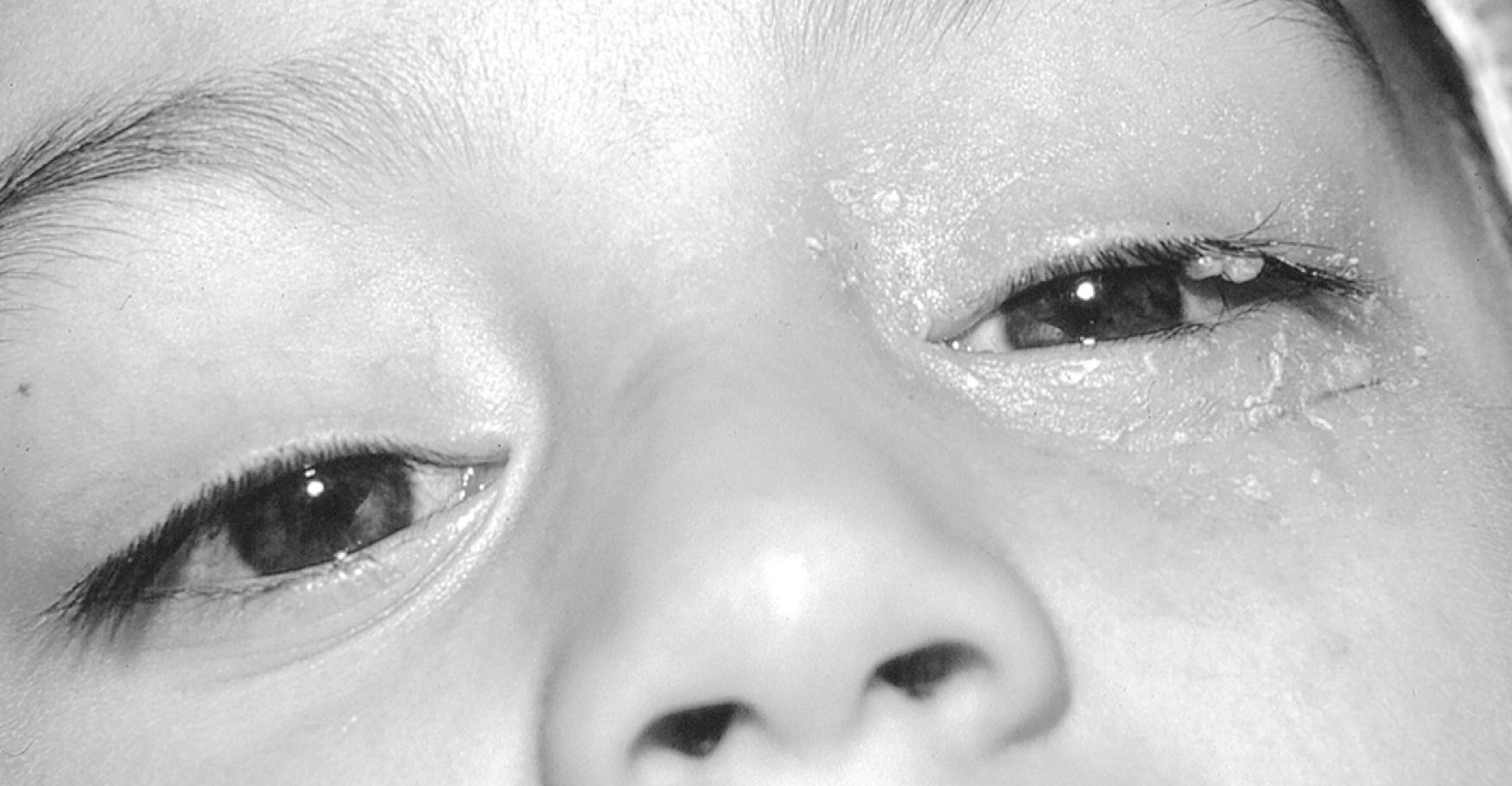
Allergic conjunctivitis manifests with a bilateral watery or mucoid discharge and must always be considered in the differential diagnosis of bilateral red eyes. The child may rub the eyes because of pruritus; nasal allergic symptoms may also be present. About 80% of individuals with allergies have ocular symptoms and these may occur in isolation. A more severe form of allergic conjunctivitis, vernal keratoconjunctivitis (VKC) , tends to occur in males in the first 2 decades of life and is seasonal, occurring in the spring and fall. Ulceration of the cornea can occur. Usually the ulceration is sterile but it can impair vision. Treatment of allergic conjunctivitis includes topical antihistamines, mast cell stabilizers, or a combination of the two. Systemic treatment of allergies often improves the ocular symptoms. In severe cases of allergic conjunctivitis or VKC, steroids or cyclosporines can be used.
Systemic syndromes must also be considered in a child with a red eye. In Stevens-Johnson syndrome, conjunctival inflammation is associated with other mucous membrane or cutaneous involvement. This disease can have severe ophthalmic consequences as a result of conjunctival scarring, changes of the eyelid position, and dry eye syndrome. Kawasaki syndrome is a febrile illness of young children who frequently manifest bilateral nonpurulent conjunctival injection and, in rare cases, iritis. Similarly, self-limited conjunctivitis can also be seen in COVID-19–associated multisystem inflammatory syndrome in children (MIS-C) and COVID-19 infections. Ophthalmic consultation may be indicated to assist in the diagnosis and management of children with Stevens-Johnson syndrome.
Become a Clinical Tree membership for Full access and enjoy Unlimited articles
If you are a member. Log in here